Energy Model for Long-Term Scenarios in Power Sector under Energy Transition Laws
Abstract
:1. Introduction
2. Methods
2.1. Electricity Demand
2.2. Model Formulation
2.3. Solution Strategy
3. Results
3.1. Electricity Demand
3.2. TAC of Electricity Power Generation and Optimized Centrals Number
3.2.1. LVF Population Model
3.2.2. CVF Population Model
3.2.3. CO2eq Emissions
4. Discussion
5. Conclusions
Author Contributions
Funding
Conflicts of Interest
Appendix A
| VARIABLES EFdemand, TAC; POSITIVE VARIABLES | |
| Energy contributions (MWh) | |
| Ffos | FOSSIL |
| Frenv | CLEAN |
| Ffoscarb | CARBON |
| Ffoscomb | FUEL OIL |
| Ffosdis | DIESEL |
| Ffosgas | GAS |
| Frenvbio | BIOMASS |
| Frenvcscrb | CARBON CAPTURE AND STORAGE |
| Frenveol | EOLIC |
| Frenvftv | PHOTOVOLTAIC |
| Frenvgtm | GEOTHERMIC |
| Frenvhdr | HYDRAULIC |
| Frenvnucl | NUCLEAR |
| Frenvsc | SOLAR CONCENTRATION |
| *****************************************COSTS************************************************* | |
| TAC | TOTAL ANNUAL COST FROM FOSSIL AND CLEAN |
| Costfos | FOSSIL |
| Costrenv | CLEAN |
| Costfoscarb | CARBON |
| Costfoscomb | FUEL OIL |
| Costfosdis | DIESEL |
| Costfosgas | GAS |
| Costrenvbio | BIOMASS |
| Costrenvcscrb | CARBON CAPTURE AND STORAGE |
| Costrenveol | EOLIC |
| Costrenvftv | PHOTOVOLTAIC |
| Costrenvgtm | GEOTHERMIC |
| Costrenvhdr | HYDRAULIC |
| Costrenvnucl | NUCLEAR |
| Costrenvftrm | SOLAR CONCENTRATION |
| *****************************CO2 Emission (kg/MWh)************************************************ | |
| EFdeman | TOTAL EMISSION FROM FOSSIL AND CLEAN |
| EFfos | FOSSIL |
| EFrenv | CLEAN |
| EFfoscarb | CARBON |
| EFfoscomb | OIL FUEL |
| EFfosdis | DIESEL |
| EFfosgas | GAS |
| EFrenvbio | BIOMASS |
| EFrenvcscrb | CARBON CAPTURE AND STORAGE |
| EFrenveol | EOLIC |
| EFrenvftv | PHOTOVOLTAIC |
| EFrenvgtm | GEOTHERMIC |
| EFrenvhdr | HYDRAULIC |
| EFrenvnucl | NUCLEAR |
| EFrenvftrm | SOLAR CONCENTRATION |
| ********************* NUMBER OF POWER PLANTS GENERATION ********************************** | |
| xtot | TOTAL |
| xf | FOSSILS |
| xr | CLEAN |
| xfoscarb | CARBON |
| xfoscomb | FUEL OIL |
| xfosdis | DIESEL |
| xfosgas | GAS |
| xrenvbio | BIOMASA |
| xrenvcscrb | CARBON CAPTURE AND STORAGE |
| xrenveol | EOLICA |
| xrenvftv | PHOTOVOLTAIC |
| xrenvgtm | GEOTHERMIC |
| xrenvhdr | HYDRAULIC |
| xrenvnucl | NUCLEAR |
| xrenvftrm | SOLAR CONCENTRATION |
| PARAMETERS | ||
| *************************************************COSTS (USD/MWh neto)********************************************* | ||
| ******************************* INVESTMENT COSTS BY ENERGY FUEL***************************************** | ||
| afoscarb | CARBON | /37.39/ |
| afoscomb | OIL FUEL | /41.891/ |
| afosdis | DIESEL | /64.16/ |
| afosgas | GAS | /72.53/ |
| arenvbio | BIOMASS | /150/ |
| arenvcscrb | CARBON CAPTURE AND STORAGE | /47.39/ |
| arenveol | EOLIC | /1.65E6/ |
| arenvftv | PHOTOVOLTAIC | /5.11E6/ |
| arenvgtm | GEOTHERMIC | /3.18E6/ |
| arenvhdr | HYDRAULIC | /2.0E6/ |
| arenvnucl | NUCLEAR | /87.93/ |
| arenvftrm | SOLAR CONCENTRATION | /180/ |
| bfoscarb | CARBON | /27.57/ |
| bfoscomb | OIL FUEL | /93.89/ |
| bfosdis | DIESEL | /147.06/ |
| bfosgas | GAS | /49.37/ |
| brenvbio | BIOMASS | /7.9/ |
| brenvcscrb | CARBON CAPTURE AND STORAGE | /27.67/ |
| brenveol | EOLICA | /0/ |
| brenvftv | PHOTOVOLTAIC | /0/ |
| brenvgtm | GEOTHERMIC | /50.12/ |
| brenvhdr | HYDRAULIC | /6.38/ |
| brenvftrm | SOLAR CONCENTRATION | /0/ |
| OPERATION AND MAINTENANCE COST, INCLUDING FIXED AND VARIABLE COSTS * | ||
| cfoscarb | CARBON | /8.13/ |
| cfoscomb | OIL FUEL | /9.21/ |
| cfosdis | DIESEL | /12.88/ |
| cfosgas | GAS | /11.33/ |
| crenvbio | BIOMAS | /4.33/ |
| crenvcscrb | CARBON CAPTURE AND STORAGE | /8.13/ |
| crenveol | EOLIC | /1.75/ |
| crenvftv | PHOTOVOLTAIC | /7.72/ |
| crenvgtm | GEOTHERMIC | /19.41/ |
| crenvhdr | HYDRAULICA | /5.71/ |
| crenvftrm | SOLAR CONCENTRATION | /20/ |
| *********************** CO2eq BY FUEL (Kg CO2/MWh)************************ | ||
| ECO2eqfoscarb | CARBON | /1089.81/ |
| ECO2eqfoscomb | OIL FUEL | /822/ |
| ECO2eqfosdis | DIESEL | /274.44/ |
| ECO2eqfosgas | GAS | /524/ |
| ECO2eqrenvbio | BIOMAS | /1403.75/ |
| ECO2eqrenvcscrb | CARBON CAPTURE AND STORAGE | /217.2/ |
| ECO2eqrenveol | EOLIC | /210/ |
| ECO2eqrenvftv | PHOTOVOLTAIC | /106/ |
| ECO2eqrenvgtm | GEOTHERMIC | /372/ |
| ECO2eqrenvhdr | HYDRAULIC | /15/ |
| ECO2eqrenvftrm | SOLAR CONCENTRATION | /14/ |
| Fdemand | ANNUAL NATIONAL ELECTRICITY DEMAND MWh | /246381740/ |
| * ELECTRICITY CONTRIBUTION GENERATED IN A PERIOD PRIOR TO THE ANALYZED (MWh)* | ||
| Ffcarbins | CARBON | /18380000/ |
| Ffcombins | OIL FUEL | /6451200/ |
| Ffdisins | DIESEL | /780000/ |
| Ffgasins | GAS | /27166000/ |
| Frbioins | BIOMAS | /0/ |
| Frcscrbins | CARBON CAPTURE AND STORAGE | /0/ |
| Freolins | EOLIC | /5000/ |
| Frftvins | PHOTOVOLTAIC | /00/ |
| Frgtmins | GEOTHERMIC | /729900/ |
| Frhdrins | HYDRAULIC | /26851000/ |
| Frnuclins | NUCLEAR | /1080500/ |
| Frftrmins | SOLAR CONCENTRATION | /0/ |
| ***************************** CAPACITY OF POWER PLANT (MW)***************************************** | |||
| Fcapfoscarb | CARBON | /2600/ | |
| Fcapfoscomb | OIL FUEL | /12711/ | |
| Fcapfosdis | DIESEL | /182/ | |
| Fcapfosgas | GAS | /7230/ | |
| Fcaprenvbio | BIOMASA | /1500/ | |
| Fcaprenvcscrb | CARBON CAPTURE AND STORAGE | /1000/ | |
| Fcaprenveol | EOLIC | /20000/ | |
| Fcaprenvftv | PHOTOVOLTAIC | /1000/ | |
| Fcaprenvgtm | GEOTHERMIC | /1000/ | |
| Fcaprenvhdr | HYDRAULIC | /10270/ | |
| Fcaprenvnucl | NUCLEAR | /1365/ | |
| Fcaprenvftrm | SOLAR CONCENTRATION | /960/ | |
| EQUATIONS | |||
| R1 | ANNUAL ELECTRICY DEMAND | ||
| R2 | FOSSIL FUEL CONTRUIBUTION TO ELECTRICITY DEMAND | ||
| R3 | CLEAN FUEL CONTRUIBUTION TO ELECTRICITY DEMAND | ||
| R4 | ELECTRICITY GENERATION FROM CARBON | ||
| R5 | ELECTRICITY GENERATION FROM FUEL OIL | ||
| R6 | ELECTRICITY GENERATION FROM DIESEL | ||
| R7 | ELECTRICITY GENERATION FROM GAS | ||
| R8 | ELECTRICITY GENERATION FROM BIOMAS | ||
| R9 | ELECTRICITY GENERATION FROM CARBON CAPTURE AND STORAGE | ||
| R10 | ELECTRICITY GENERATION FROM EOLIC | ||
| R11 | ELECTRICITY GENERATION FROM PHOTOVOLTAIC | ||
| R12 | ELECTRICITY GENERATION FROM GEOTHERMAL | ||
| R13 | ELECTRICITY GENERATION FROM HYDRAULIC | ||
| R14 | ELECTRICITY GENERATION FROM NUCLEAR | ||
| R15 | ELECTRICITY GENERATION FROM SOLAR CONCENTRATION | ||
| *************************************COSTS******************************************** | |||
| R16 | TOTAL ANNUAL COST OF ELECTRICITY GENERATION | ||
| R17 | TOTAL ANNUAL COST OF ELECTRICITY GENERATION FROM FOSSIL FUELS | ||
| R18 | TOTAL ANNUAL COST OF ELECTRICITY GENERATION FROM CLEAN FUELS | ||
| R19 | TOTAL ANNUAL COST OF ELECTRICITY GENERATION FROM CARBON | ||
| R20 | TOTAL ANNUAL COST OF ELECTRICITY GENERATION FROM OIL FUEL | ||
| R21 | TOTAL ANNUAL COST OF ELECTRICITY GENERATION FROM DIESEL | ||
| R22 | TOTAL ANNUAL COST OF ELECTRICITY GENERATION FROM GAS | ||
| R23 | TOTAL ANNUAL COST OF ELECTRICITY GENERATION FROM BIOMAS | ||
| R24 | TOTAL ANNUAL COST OF ELECTRICITY GENERATION FROM CARBON CAPTURE AND STORAGE | ||
| R25 | TOTAL ANNUAL COST OF ELECTRICITY GENERATION FROM EOLIC | ||
| R26 | TOTAL ANNUAL COST OF ELECTRICITY GENERATION FROM PHOTOVOLTAIC | ||
| R27 | TOTAL ANNUAL COST OF ELECTRICITY GENERATION FROM GEOTHERMAL | ||
| R28 | TOTAL ANNUAL COST OF ELECTRICITY GENERATION FROM HYDRAULIC | ||
| R29 | TOTAL ANNUAL COST OF ELECTRICITY GENERATION FROM NUCLEAR | ||
| R30 | TOTAL ANNUAL COST OF ELECTRICITY GENERATION FROM SOLAR CONCENTRATION | ||
| *************************************CO2eq EMISSIONS******************************************** | |||
| R31 | CO2eq EMISSION FROM TOTAL ELECTRICITY GENERATION | ||
| R32 | CO2eq EMISSION FROM ELECTRICITY GENERATION FROM FOSSIL FUELS | ||
| R33 | CO2eq EMISSION FROM ELECTRICITY GENERATION FROM CLEAN FUELS | ||
| R34 | CO2eq EMISSION FROM ELECTRICITY GENERATION FROM CARBON | ||
| R35 | CO2eq EMISSION FROM ELECTRICITY GENERATION FROM FUEL OIL | ||
| R36 | CO2eq EMISSION FROM ELECTRICITY GENERATION FROM DIESEL | ||
| R37 | CO2eq EMISSION FROM ELECTRICITY GENERATION FROM GAS | ||
| R38 | CO2eq EMISSION FROM ELECTRICITY GENERATION FROM BIOMAS | ||
| R39 | CO2eq EMISSION FROM ELECTRICITY GENERATION FROM CARBON CAPTURE AND STORAGE | ||
| R40 | CO2eq EMISSION FROM ELECTRICITY GENERATION EOLIC | ||
| R41 | CO2eq EMISSION FROM ELECTRICITY GENERATION PHOTOVOLTAIC | ||
| R42 | CO2eq EMISSION FROM ELECTRICITY GENERATION GEOTHERMIC | ||
| R43 | CO2eq EMISSION FROM ELECTRICITY GENERATION HYDRAULIC | ||
| R44 | CO2eq EMISSION FROM ELECTRICITY GENERATION NUCLEAR | ||
| R45 | CO2eq EMISSION FROM ELECTRICITY GENERATION SOLAR CONCENTRATION | ||
| *************************************RESTRICTIONS******************************************** | |||
| R46 | ELECTRICITY CONTRIBUTION FROM CARBON | ||
| R47 | ELECTRICITY CONTRIBUTION FROM FUEL OIL | ||
| R48 | ELECTRICITY CONTRIBUTION FROM DIESEL | ||
| R49 | ELECTRICITY CONTRIBUTION FROM GAS | ||
| R50 | ELECTRICITY CONTRIBUTION FROM BIOMAS | ||
| R51 | ELECTRICITY CONTRIBUTION FROM CARBON CAPTURE AND STORAGE | ||
| R52 | ELECTRICITY CONTRIBUTION FROM EOLIC | ||
| R53 | ELECTRICITY CONTRIBUTION FROM PHOTOVOLTAIC | ||
| R54 | ELECTRICITY CONTRIBUTION FROM GEOTHERMIC | ||
| R55 | ELECTRICITY CONTRIBUTION FROM HYDRAULIC | ||
| R56 | ELECTRICITY CONTRIBUTION FROM NUCLEAR | ||
| R57 | ELECTRICITY CONTRIBUTION FROM SOLAR CONCENTRATION | ||
| R58 | ELECTRICITY CONTRIBUTION FROM FOSSIL FUELS | ||
| R59 | TOTAL NUMBER OF POWER PLANTS GENERATION | ||
| R60 | FOSSIL NUMBER OF POWER PLANTS GENERATION | ||
| R61 | CLEAN NUMBER OF POWER PLANTS GENERATION | ||
| ********************************************MODEL*********************************************************** ***************************************ELECTRICIY CALCULUS *************************************************** | |
| R1.. | Fdemand = E = Ffos + Frenv; |
| R2.. | Ffos = E = Ffoscarb + Ffoscomb + Ffosdis + Ffosgas; |
| R3.. | Frenv = E = Frenvbio + Frenvcscrb + Frenveol + Frenvftv + Frenvftrm + Frenvgtm + Frenvhdr + Frenvnucl; |
| *************************FÓSILES***************************************************************************** | |
| R4.. | Ffoscarb =L= Ffcarbins + ( Fcapfoscarb * xfoscarb * 8760 * fafoscarb); |
| R5.. | Ffoscomb =L= Ffcombins + ( Fcapfoscomb * xfoscomb * 8760 * fafoscomb); |
| R6.. | Ffosdis =L= Ffdisins + ( Fcapfosdis * xfosdis * 8760 * fafosdis); |
| R7.. | Ffosgas =L= Ffgasins + ( Fcapfosgas * xfosgas * 8760 * fafosgas); |
| *************************RENOVABLES************************************************************************** | |
| R8.. | Frenvbio =L= Frbioins + ( Fcaprenvbio * xrenvbio * 8760 * farenvbio) ; |
| R9.. | Frenvcscrb =L= Frcscrbins + ( Fcaprenvcscrb * xrenvcscrb * 8760 * farenvcscrb) ; |
| R10.. | Frenveol =L= Freolins + ( Fcaprenveol * xrenveol * 8760 * farenveol) ; |
| R11.. | Frenvftv =L= Frftvins + ( Fcaprenvftv * xrenvftv * 8760 * farenvftv) ; |
| R12.. | Frenvftrm =L= Frftrmins + ( Fcaprenvftrm * xrenvftrm * 8760 * farenvftrm) ; |
| R13.. | Frenvgtm =L= Frgtmins + ( Fcaprenvgtm * xrenvgtm * 8760 * farenvgtm) ; |
| R14.. | Frenvhdr =L= Frhdrins + ( Fcaprenvhdr * xrenvhdr * 8760 * farenvhdr) ; |
| R15.. | Frenvnucl =L= Frnuclins + ( Fcaprenvnucl * xrenvnucl * 8760 * farenvnucl) ; |
| ********************************************************************************* | |
| ********************************COST CALCULUS************************************************************ | |
| R16.. | TAC =E= Costfos + Costrenv ; |
| R17.. | Costfos =E= Costfoscarb + Costfoscomb + Costfosdis + Costfosgas ; |
| R18.. | Costrenv =E= Costrenvbio + Costrenvcscrb + Costrenveol + Costrenvftv + Costrenvftrm + Costrenvgtm + Costrenvhdr + Costrenvnucl; |
| R19.. | Costfoscarb =E= Ffoscarb * (afoscarb + bfoscarb + cfoscarb) * 1000 ; |
| R20.. | Costfoscomb =E= Ffoscomb * (afoscomb + bfoscomb + cfoscomb) * 1000 ; |
| R21.. | Costfosdis =E= Ffosdis * (afosdis + bfosdis + cfosdis) * 1000 ; |
| R22.. | Costfosgas =E= Ffosgas * (afosgas + bfosgas + cfosgas) * 1000 ; |
| R23.. | Costrenvbio =E= Frenvbio * (arenvbio + brenvbio + crenvbio) * 1000 ; |
| R24.. | Costrenvcscrb =E= Frenvcscrb * (arenvcscrb + brenvcscrb + crenvcscrb) * 1000 ; |
| R25.. | Costrenveol =E= Frenveol * (arenveol + brenveol + crenveol) * 1000 ; |
| R26.. | Costrenvftv =E= Frenvftv * (arenvftv + brenvftv + crenvftv) * 1000 ; |
| R27.. | Costrenvgtm =E= Frenvgtm * (arenvgtm + brenvgtm + crenvgtm) * 1000 ; |
| R28.. | Costrenvhdr =E= Frenvhdr * (arenvhdr + brenvhdr + crenvhdr) * 1000 ; |
| R29.. | Costrenvnucl =E= Frenvnucl * (arenvnucl + brenvnucl + crenvnucl) * 1000 |
| R30.. | Costrenvftrm =E= Frenvftrm * (arenvftrm + brenvftrm + crenvftrm) * 1000 ; |
| ******************************************************************************** | |
| R31.. | EFdemand =E= EFfos + EFrenv; |
| *********************************************************************************************************** | |
| **************************** EMISSIONS CALCULUS******************************************* | |
| R32.. | EFfos =E= EFfoscarb + EFfoscomb + EFfosdis + EFfosgas ; |
| R33.. | EFrenv =E= EFrenvbio + EFrenvcscrb + EFrenveol + EFrenvftv + EFrenvftrm + EFrenvgtm + EFrenvhdr; |
| ***************************DE FUENTES FÓSILES******************************************************* | |
| R34.. | EFfoscarb =E= ECO2eqfoscarb * Ffoscarb ; |
| R35.. | EFfoscomb =E= ECO2eqfoscomb * Ffoscomb ; |
| R36.. | EFfosdis =E= ECO2eqfosdis * Ffosdis ; |
| R37.. | EFfosgas =E= ECO2eqfosgas * Ffosgas ; |
| ***************************DE FUENTES RENOVABLES************************************************************ | |
| R38.. | EFrenvbio =E= ECO2eqrenvbio * Frenvbio ; |
| R39.. | EFrenvcscrb =E= ECO2eqrenvcscrb * Frenvcscrb ; |
| R40.. | EFrenveol =E= ECO2eqrenveol * Frenveol ; |
| R41.. | EFrenvftv =E= ECO2eqrenvftv * Frenvftv ; |
| R42.. | EFrenvftrm =E= ECO2eqrenvftrm * Frenvftrm ; |
| R43.. | EFrenvgtm =E= ECO2eqrenvgtm * Frenvgtm ; |
| R44.. | EFrenvhdr =E= ECO2eqrenvhdr * Frenvhdr ; |
| R45.. | EFrenvnucl =E= ECO2eqrenvnucl * Frenvnucl ; |
| **************************PERCENTAGE TECHNOLOGY CONTRIBUTIONS************************** | |
| R46.. | Ffoscarb =L= Ffos ; |
| R47.. | Ffoscomb =L= Ffos ; |
| R48.. | Ffosdis =L= Ffos ; |
| R49.. | Ffosgas =L= Ffos ; |
| R50.. | Frenvbio =L= Fdemand - Ffos ; |
| R51.. | Frenvcscrb =L= Fdemand - Ffos ; |
| R52.. | Frenveol =L= Fdemand - Ffos ; |
| R53.. | Frenvftv =L= Fdemand - Ffos ; |
| R54.. | Frenvftrm =L= Fdemand - Ffos ; |
| R55.. | Frenvgtm =L= Fdemand - Ffos ; |
| R56.. | Frenvhdr =L= Fdemand - Ffos ; |
| R57.. | Frenvnucl =L= Fdemand - Ffos ; |
| ************FOSSIL PERCENTAGE CONTRIBUTION *********** | |
| R58.. | Ffos =L= Fdemand * 0.8132 ; |
| *****************************CENTTRAL NUMERO DE CENTRALES******************************** | |
| R59.. | xtot =E= xf + xr ; |
| R60.. | Xf =E= xfoscarb + xfoscomb + xfosdis + xfosgas ; |
| R61.. | xr =E= xrenvbio + xrenvcscrb + xrenveol + xrenvftv + xrenvftrm + xrenvgtm + xrenvhdr + xrenvnucl; |
| ***********************NUMBER OF POWER PLANTS GENERATION ***************************************** | |
| Ffoscarb.LO = Fdemand * 0.11 ; | |
| Ffoscarb.UP = Fdemand * 0.115 ; | |
| Ffoscomb.LO = Fdemand * 0.075 ; | |
| Ffoscomb.UP = Fdemand * 0.0781 ; | |
| Ffosdis.LO = Fdemand * 0.008 ; | |
| Ffosdis.UP = Fdemand * 0.01 ; | |
| Ffosgas.LO = Fdemand * 0.45 ; | |
| Ffosgas.UP = Fdemand * 0.61 ; | |
| Frenvbio.LO = Fdemand * 0.00 ; | |
| Frenvbio.UP = Fdemand * 0.003 ; | |
| Frenvcscrb.LO = Fdemand * 0.00 ; | |
| Frenvcscrb.UP = Fdemand * 0.00 ; | |
| Frenveol.LO = Fdemand * 0.190 ; | |
| Frenveol.UP = Fdemand * 0.013 ; | |
| Frenvftrm.LO = Fdemand * 0.00 ; | |
| Frenvftrm.UP = Fdemand * 0.00 ; | |
| Frenvftv.LO = Fdemand * 0.0055 ; | |
| Frenvftv.UP = Fdemand * 0.0115 ; | |
| Frenvgtm.LO = Fdemand * 0.0145 ; | |
| Frenvgtm.UP = Fdemand * 0.015 ; | |
| Frenvhdr.LO = Fdemand * 0.11 ; | |
| Frenvhdr.UP = Fdemand * 0.1194 ; | |
| Frenvnucl.LO = Fdemand * 0.05 ; | |
| Frenvnucl.UP = Fdemand * 0.027 ; | |
| MODEL PCL05 /ALL/; SOLVE PCL05 USING MIP MINIMIZING TAC; | |
References
- Farman, J.C.; Gardiner, B.G.; Shanklin, J.D. Large losses of total ozone in Antarctica reveal seasonal ClOx/NOx interaction. Nature 1985, 315, 207–210. [Google Scholar] [CrossRef]
- Montreal Protocol of Substances that Deplete the Ozone Layer. United Nations Environment Programme, Ozone Secretariat; Montreal, Canada. 1987. Available online: https://treaties.un.org/doc/Treaties/1989/01/19890101%2003-25%20AM/Ch_XXVII_02_ap.pdf (accessed on 13 August 2019).
- Kyoto Protocol to the United Nations Framework Convention on Climate Change. United Nations Framework Convention on Climate Change; Kyoto, Japan. 1998. Available online: https://unfccc.int/resource/docs/convkp/kpeng.pdf (accessed on 13 August 2019).
- Sustainable Development Goals. United Nations. Available online: https://www.un.org/sustainabledevelopment/ (accessed on 7 July 2018).
- Paris Agreement. In Proceedings of the Conference of the Parties of the United Nation Framework Convention on Climate Change, United Nations Framework Convention on Climate Change, Le Bourget, France, 15 December 2015.
- The World Bank Open Data. World Development Indicators. 2017. Available online: http://datos.bancomundial.org/indicador/EG.USE.ELEC.KH.PC?view=chart (accessed on 26 August 2019).
- National Ecology and Climate Change Institute (INECC). National Inventory of Emissions of Gases and Compounds of Greenhouse Gases. 2015. Available online: www.gob.mx/inecc/acciones-y-programas/emisiones-80133 (accessed on 26 August 2019).
- SENER; Mexican Energy State Secretariat; Secretaría de Energía. Electricity Sector Prospectives 2018–2032. Mexico City, Mexico. 2018. Available online: https://www.gob.mx/cms/uploads/attachment/file/284345/Prospectiva_del_Sector_El_ctrico_2017.pdf (accessed on 13 August 2019).
- Ruiz-Mendoza, B.J.; Sheinbaum-Pardo, C. Electricity sector reforms in four Latin-American countries and their impact on carbon dioxide emissions and renewable energy. Energy Policy 2010, 38, 6755–6766. [Google Scholar] [CrossRef]
- SEGOB; Mexican Governing Secretariat; Secretaría de Gobernación. General Climate Change Law. Mexico City, Mexico. 2012. Available online: www.diputados.gob.mx/LeyesBiblio/pdf/LGCC.pdf (accessed on 7 September 2018).
- SEMARNAT; Mexican Ministry of the Environment and Natural Resources; Undersecretary of Planning and Environmental Policy. National Climate Change Strategy; Vision 10-20-40; Secretaría del Medio Ambiente y recusos Naturales, Subsecretaría de Planeación y Política Ambiental; Dirección General de Políticas para el Cambio Climático: Mexico City, Mexico, 2013. [Google Scholar]
- SEGOB; Mexican Governing Secretariat. Secretaría de Gobernación. Energy Transition Law. Energy Transition Law; Tenth-Five Transitory from the Third Article. Ley de Transición Energética. Transitorio Décimo quinto del Artículo Tercero; Mexico City, Mexico. 2015. Available online: www.diputados.gob.mx/LeyesBiblio/pdf/LTE.pdf (accessed on 5 September 2018).
- Manzini, F.; Islas, J.; Martínez, M. Reduction of greenhouse gases using renewable energies in México in 2025. Int. J. Hidrogen Energy 2001, 26, 145–149. [Google Scholar] [CrossRef]
- Johnson, T.M.; Alatorre, C.; Romo, Z.; Lui, F. Low Carbon Development for Mexico; World Bank: Washington, DC, USA, 2009. [Google Scholar]
- Lund, H.; Mathiesen, B.V. Energy system analysis of 100% renewable energy systems—The case of Denmark in years 2030 and 2050. Energy 2009, 34, 524–531. [Google Scholar] [CrossRef]
- Santoyo-Castelazo, E.; Stamford, L.; Azapagic, A. Environmental implications of decarbonizing electricity supply in large economies: The case of Mexico. Energy Convers. Manag. 2014, 85, 272–291. [Google Scholar] [CrossRef]
- Vidal-Amaro, J.J.; Østergar, P.A.; Sheinbaum-Pardo, C. Optimal energy mix for transition from fossil fuel to renewable energy sources—The case of the Mexican electricity system. Appl. Energy 2015, 150, 80–96. [Google Scholar] [CrossRef]
- International Energy Agency (IEA). CO2 Emissions from Fuel Combustion, Highlights: Paris, France. November 2017.
- Department of Economic and Social Affairs; United Nations. World Population Prospects. 2017. Available online: https://esa.un.org/unpd/wpp/Graphs/Probabilistic/POP/TOT/ (accessed on 29 March 2018).
- Federal Electricity Commission (CFE); COPAR. Costos y Parámetros de Referencia para la Formulación de Proyectos de Inversión en el Sector Eléctrico. Generation, Costs and Reference Parameters for the Formulation of Investment Projects in the Electricity Sector. Mexico, Programmation Subdirection; Evaluation Coordination; México. 2012. [Google Scholar]
- Intergovernmental Panel of Climate Change; Renewable Energy Sources and Climate Change Mitigation. Special Report of the Intergovernmental Panel of Climate Change, 1th ed.; Cambridge University: Cambridge, MA, USA, 2012. [Google Scholar]
- Diwekar, U.M. Introduction to Applied Optimization, 2nd ed.; Springer: New York, NY, USA, 2008. [Google Scholar]
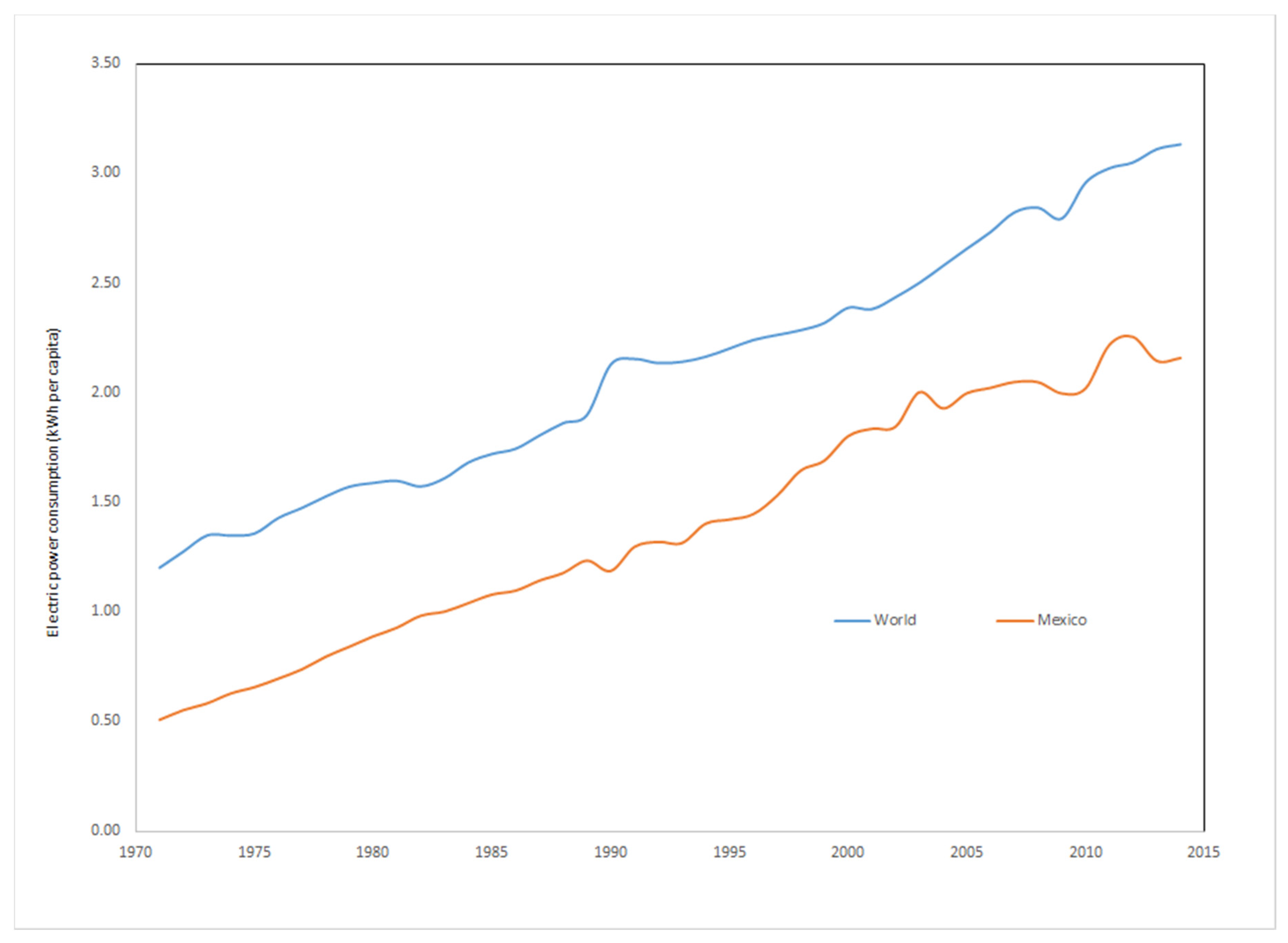
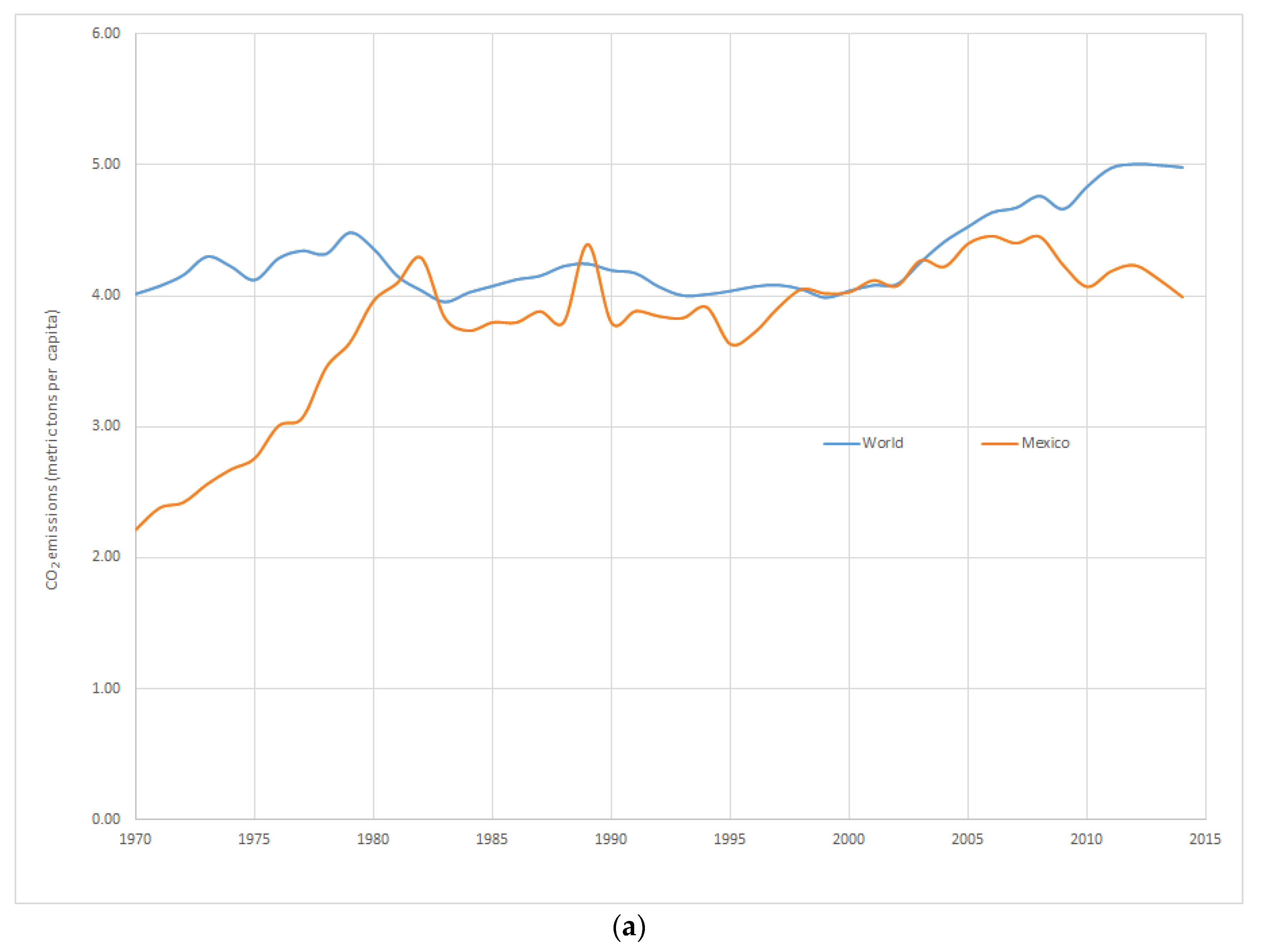
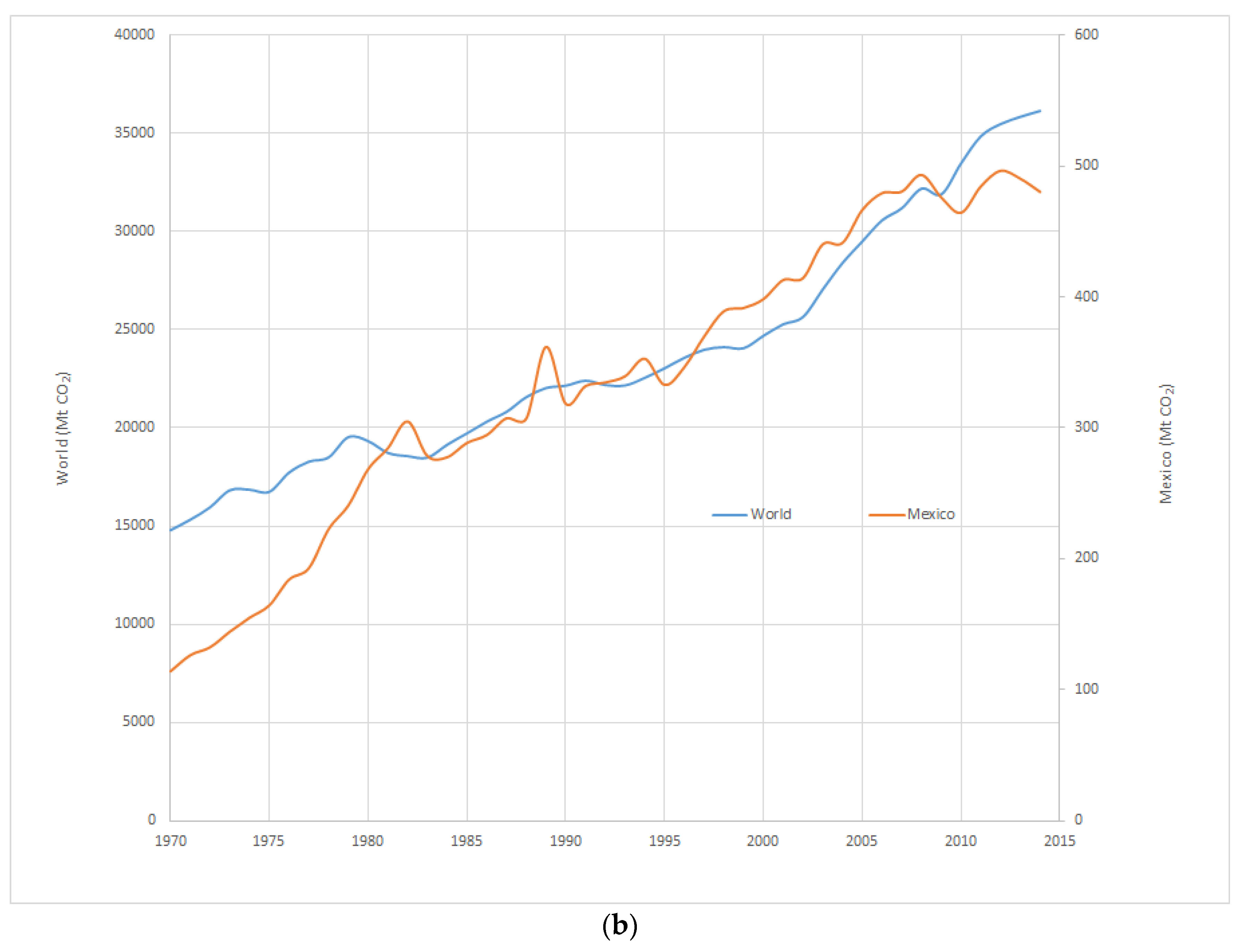
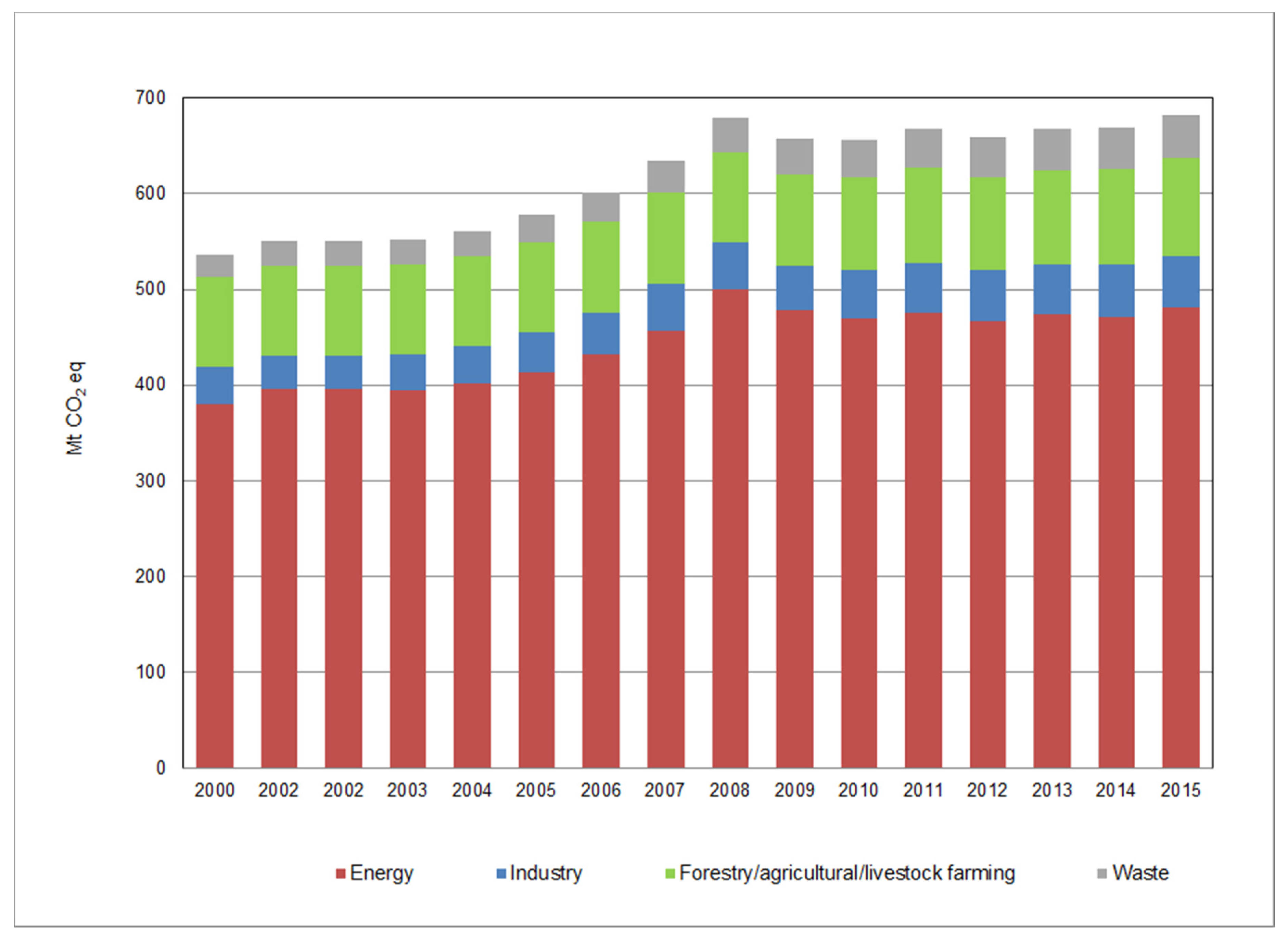
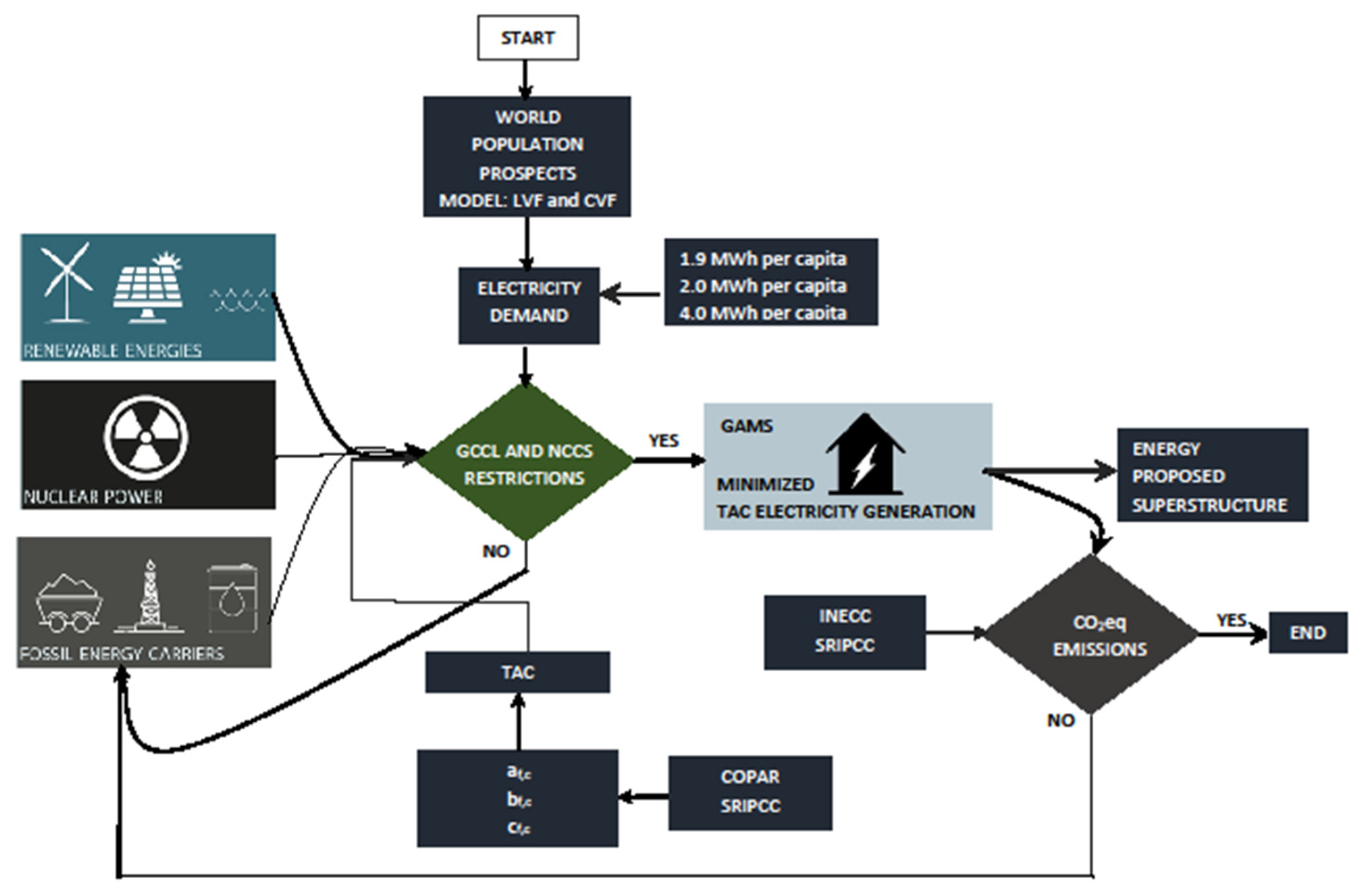
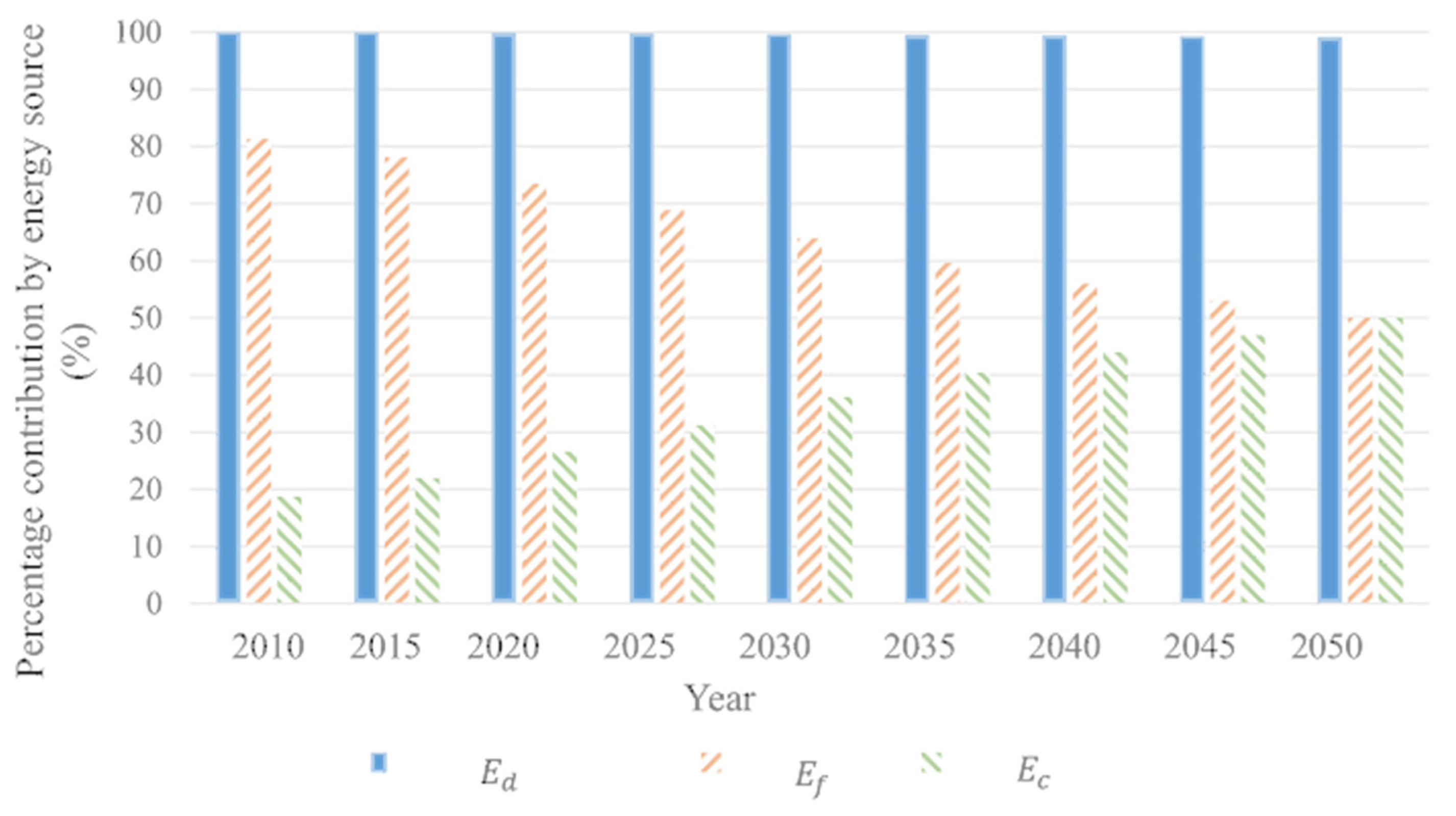
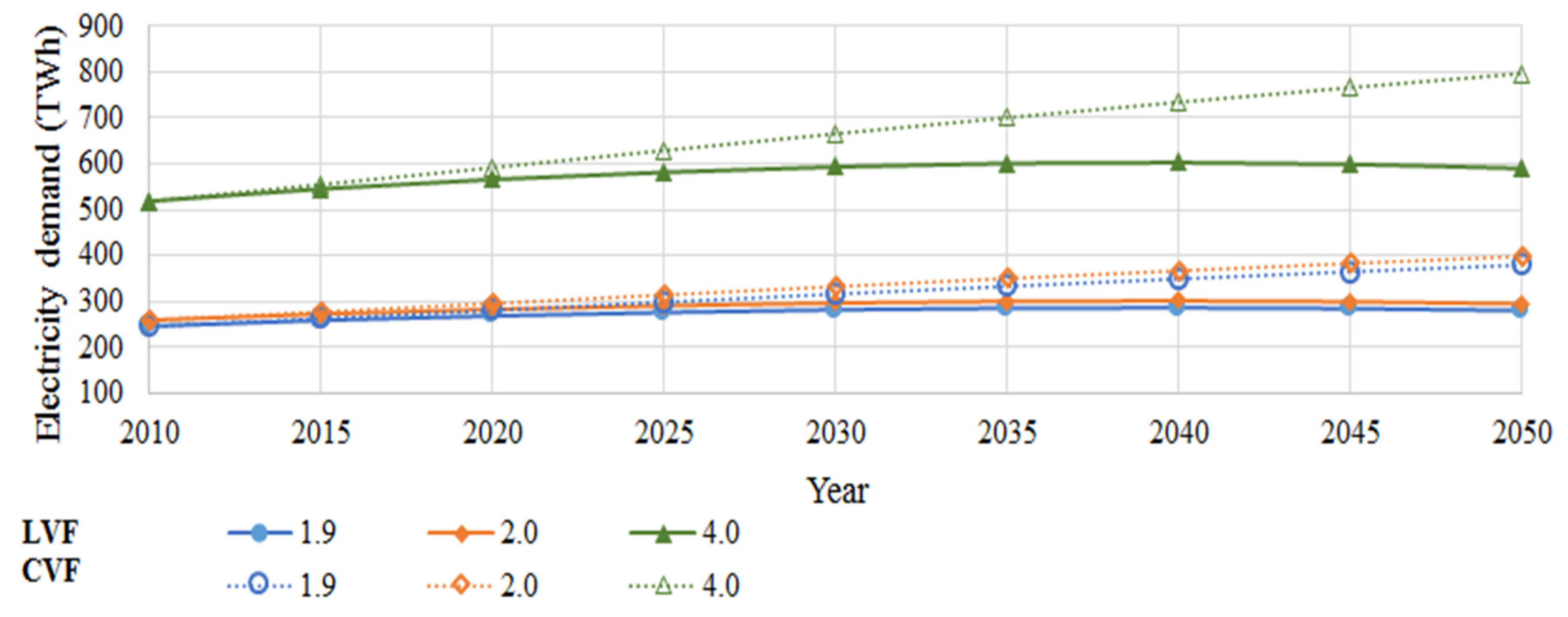
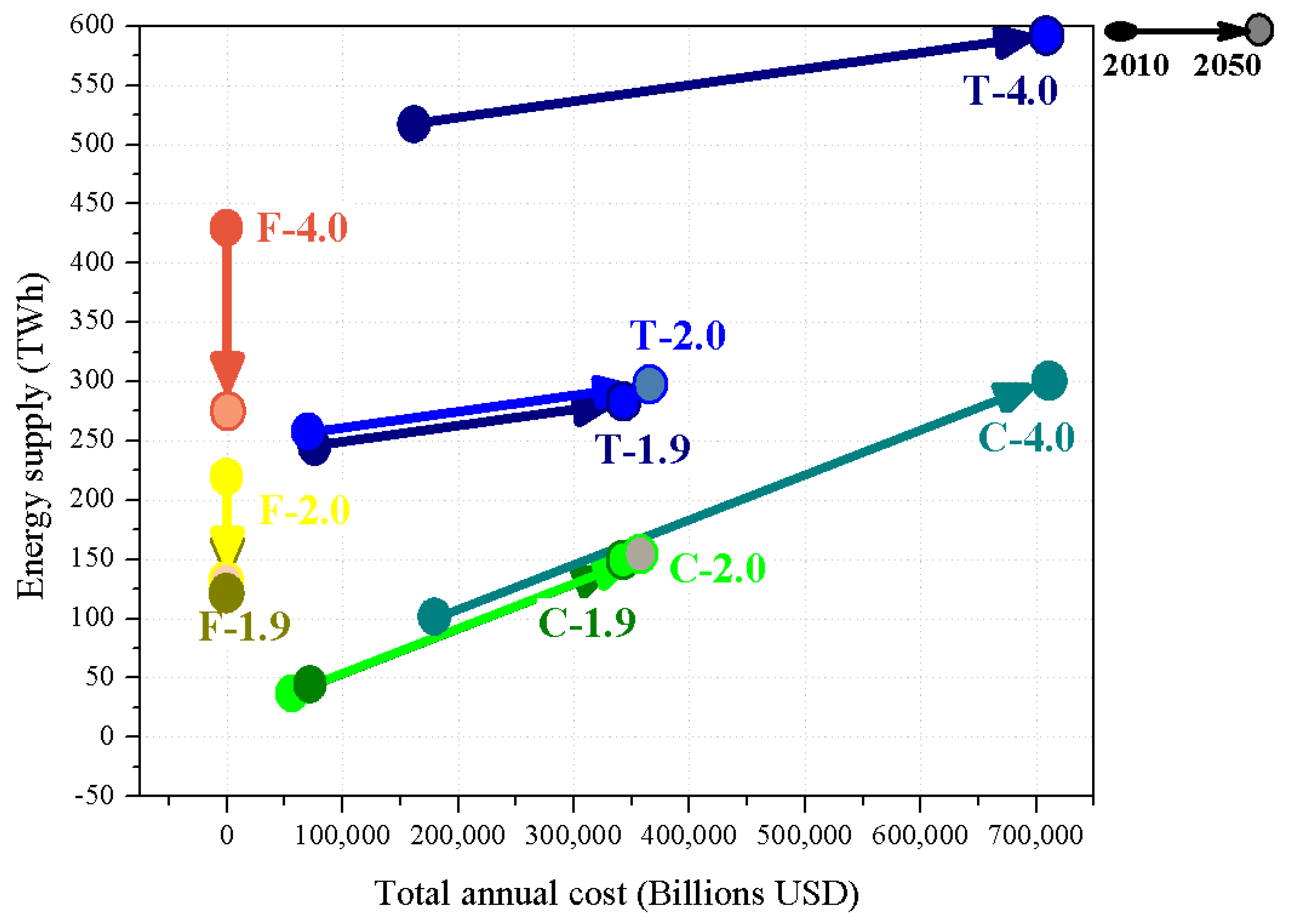
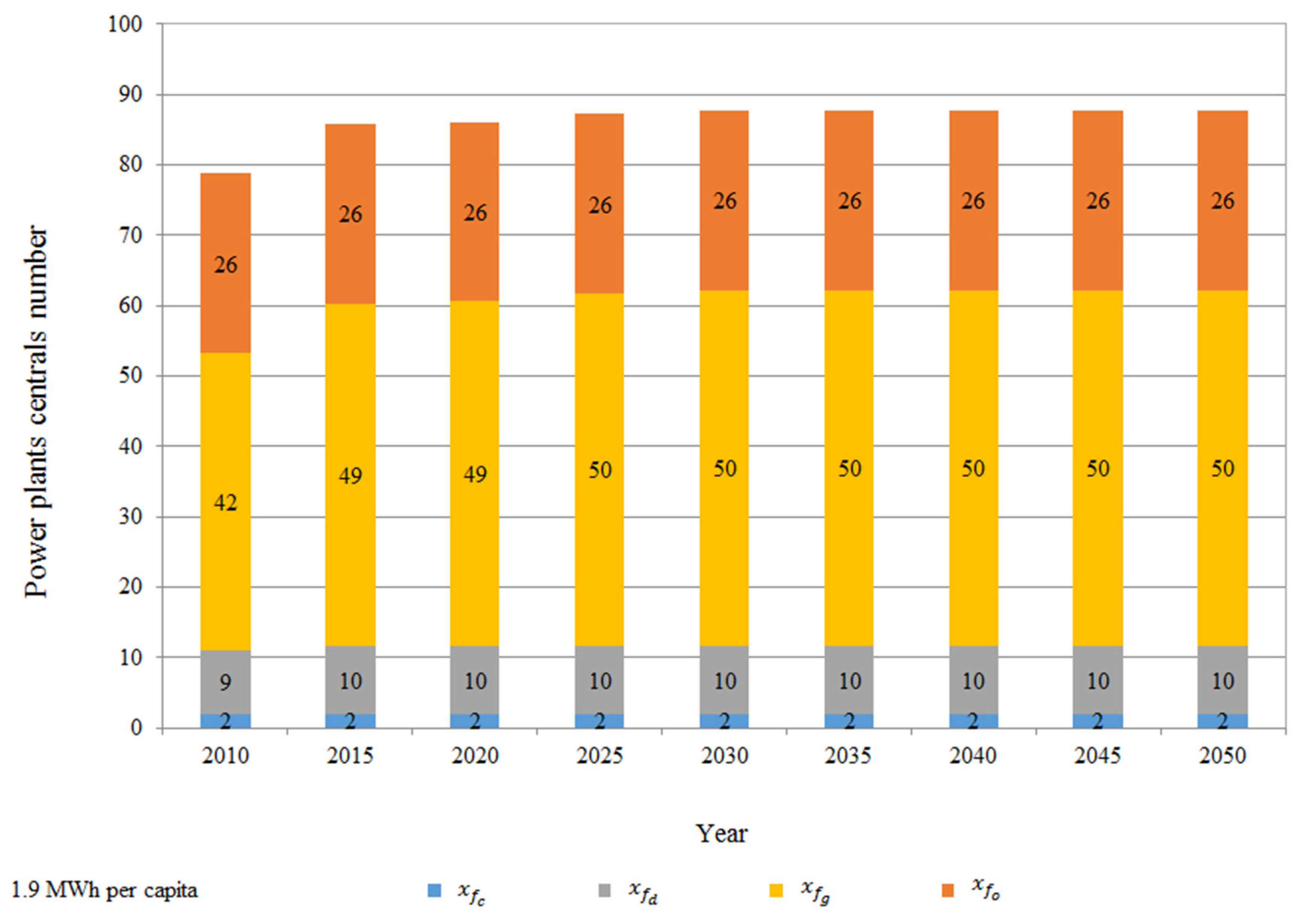
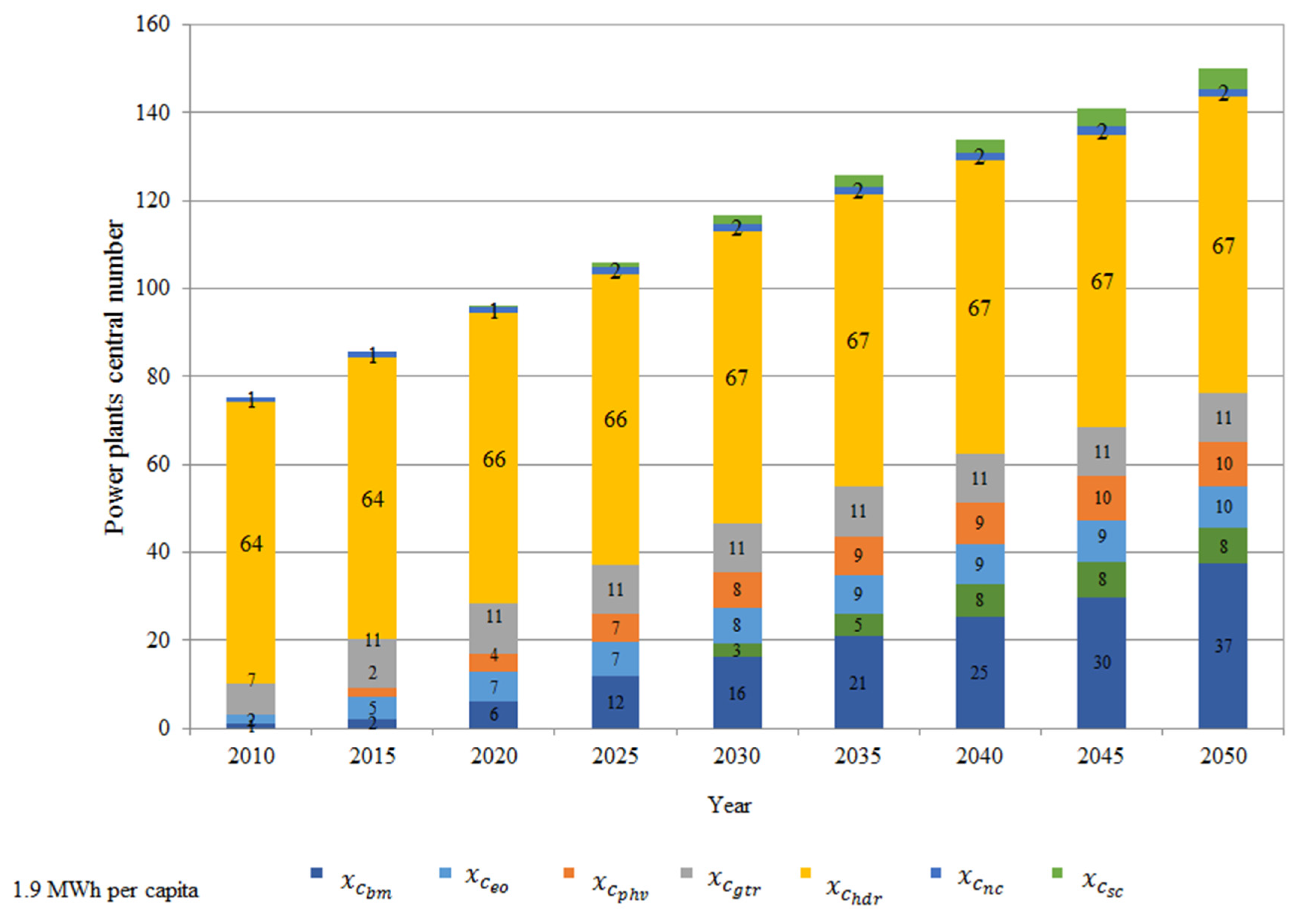
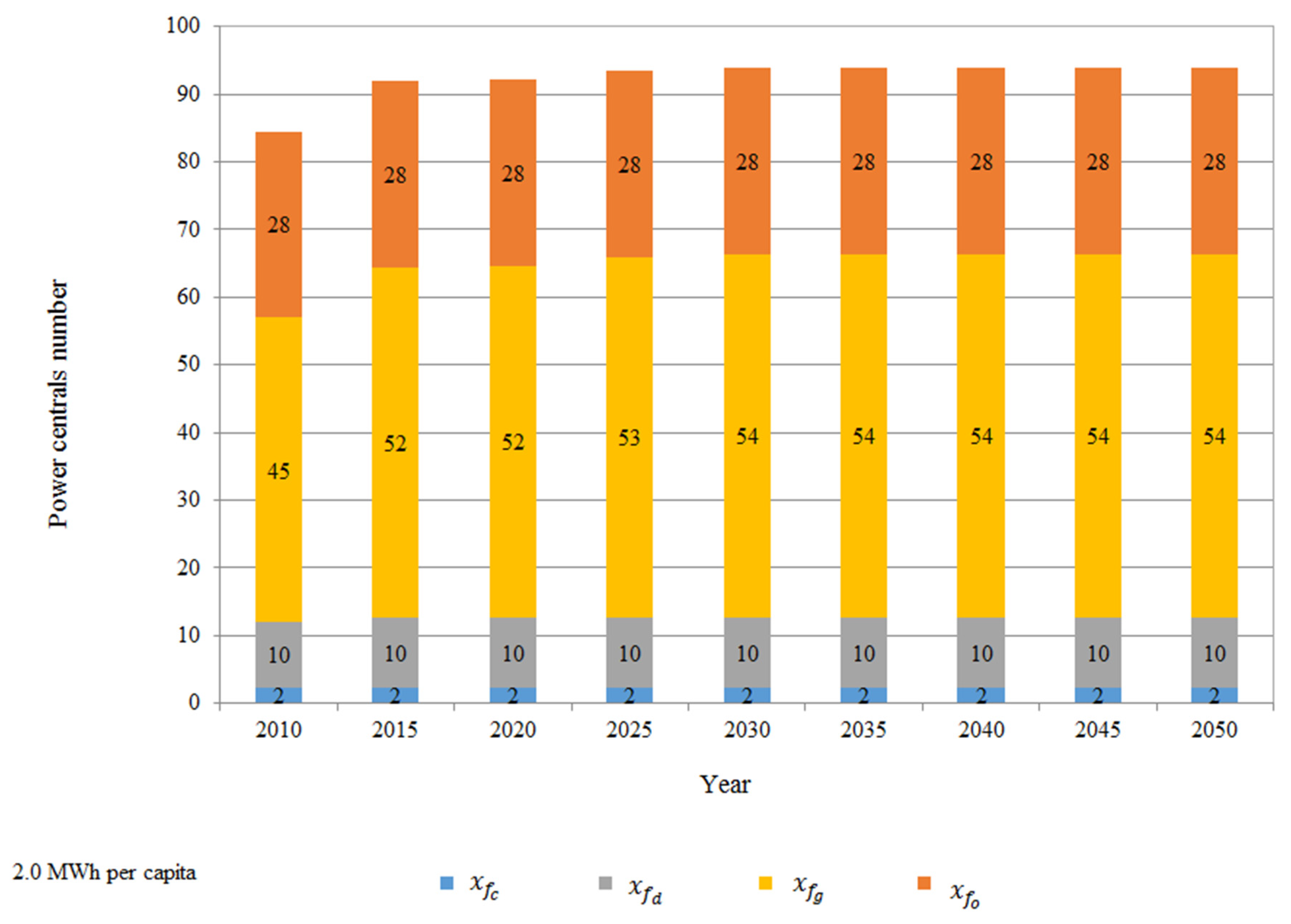
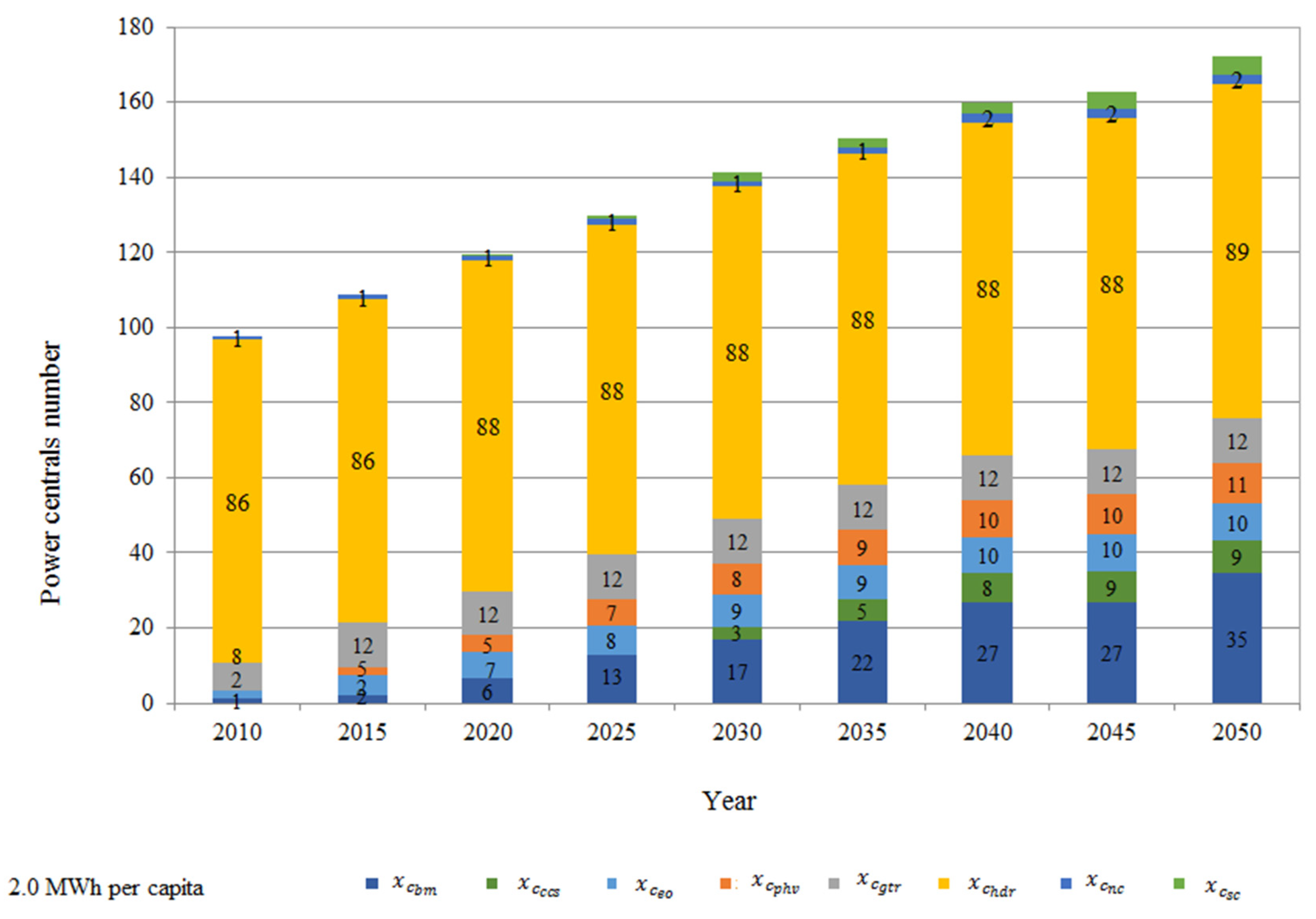
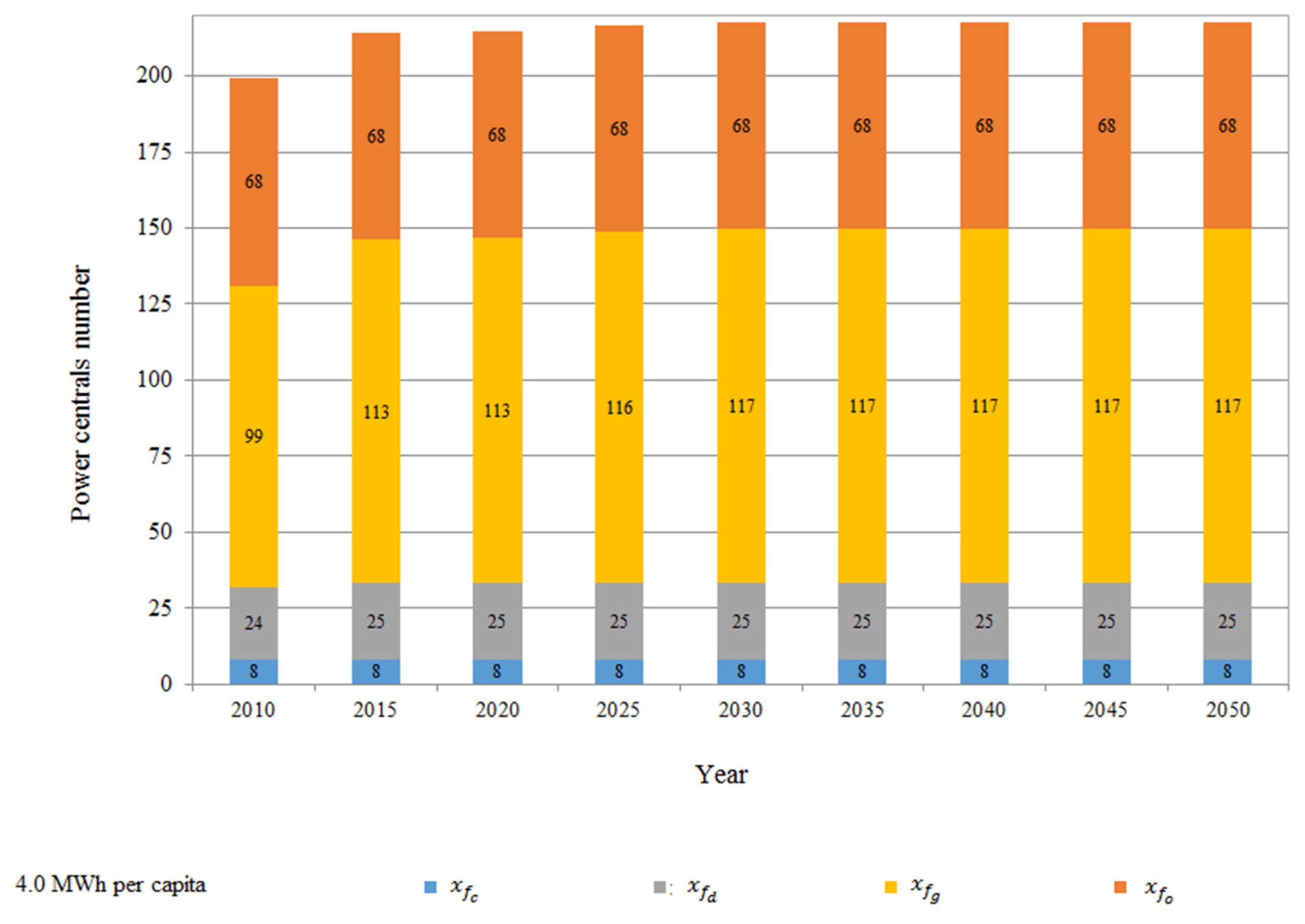
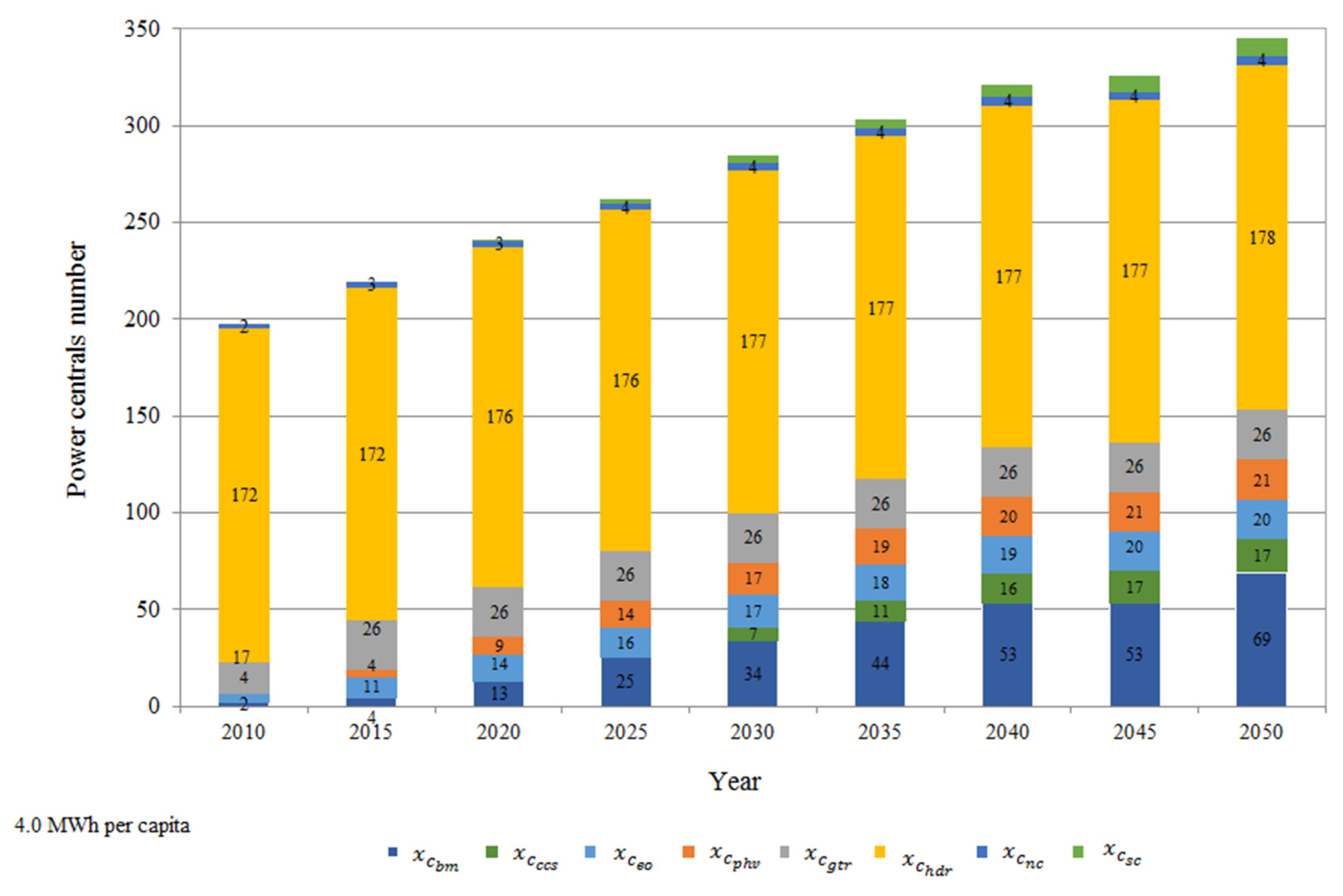

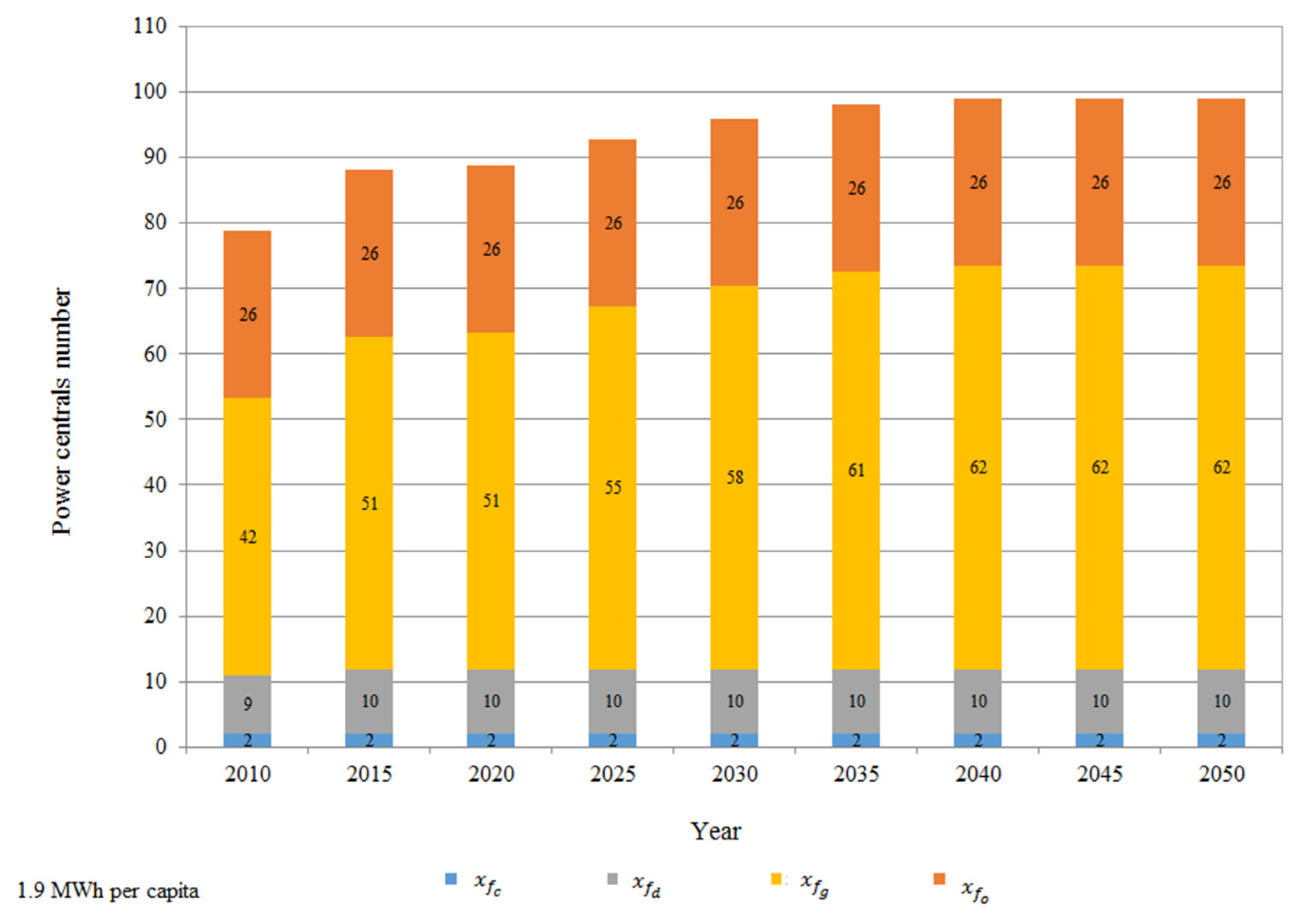
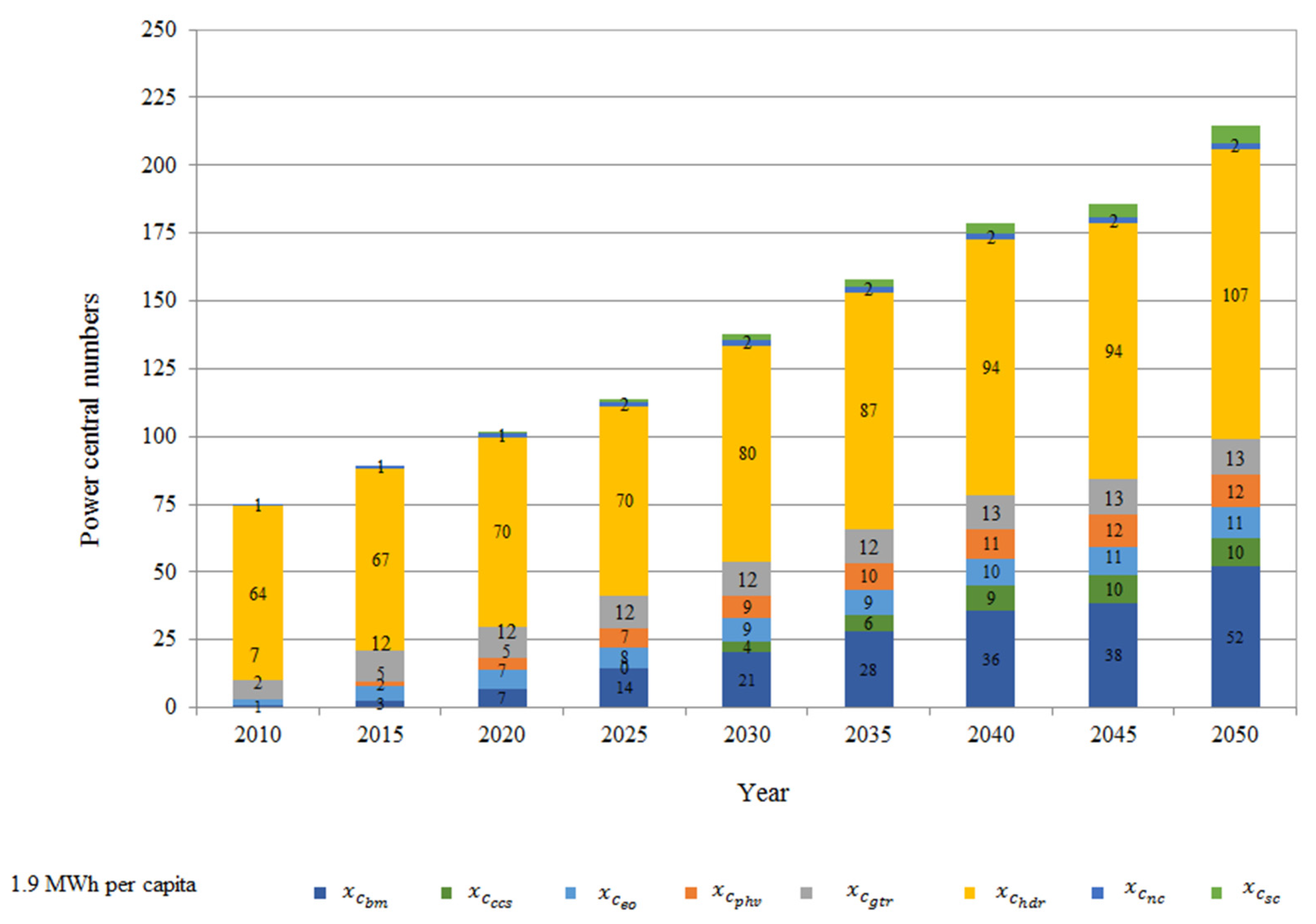
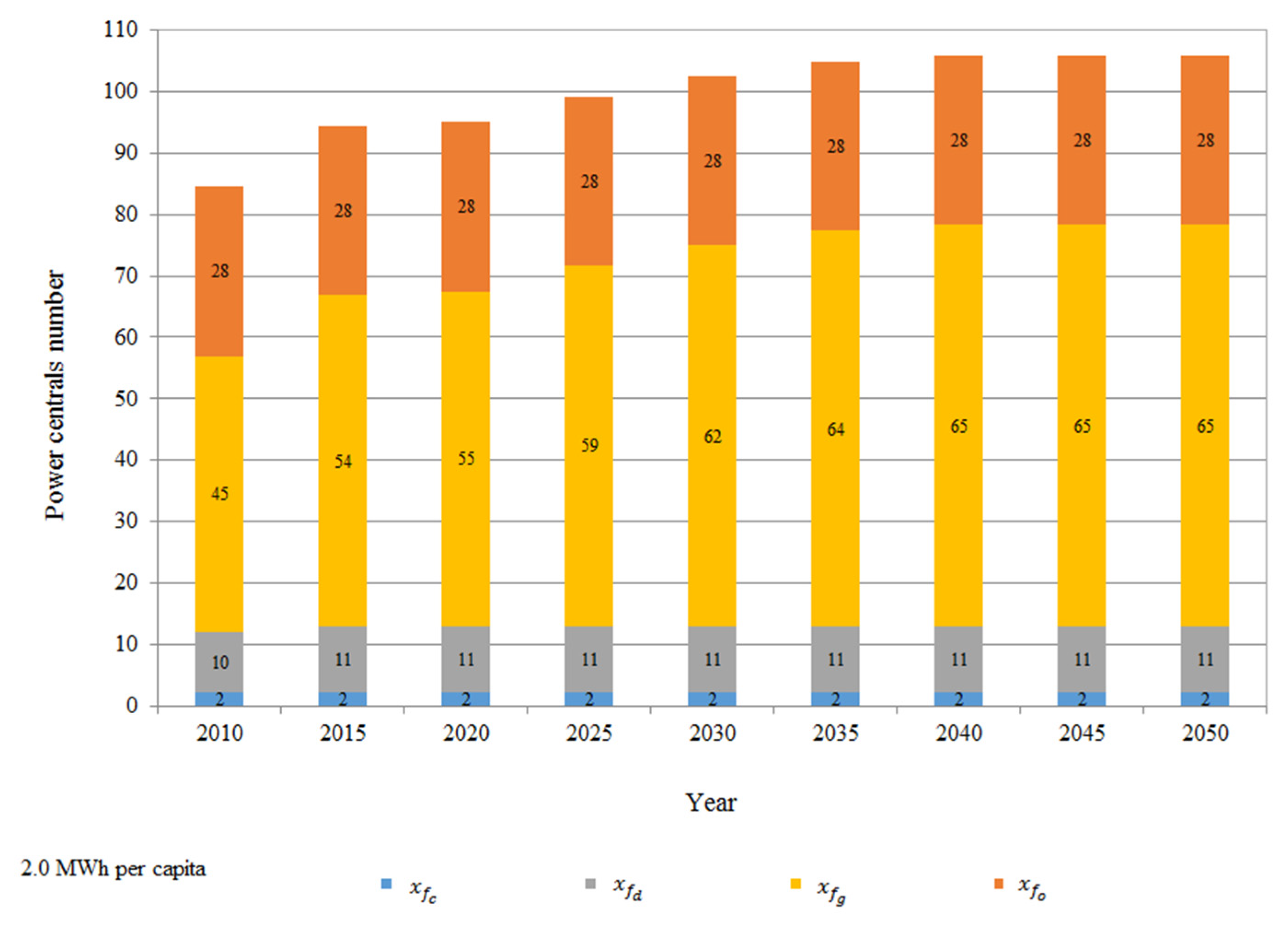
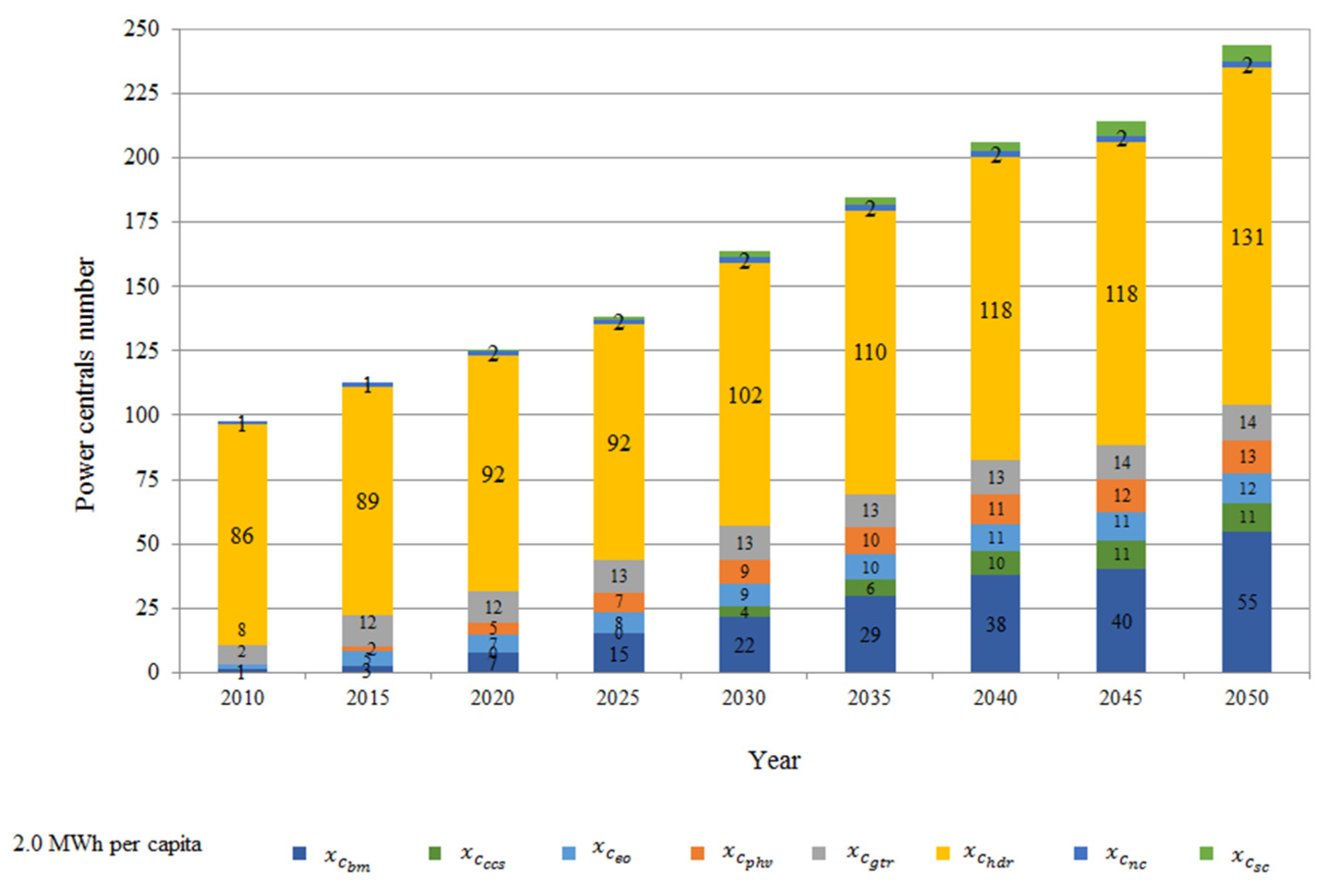
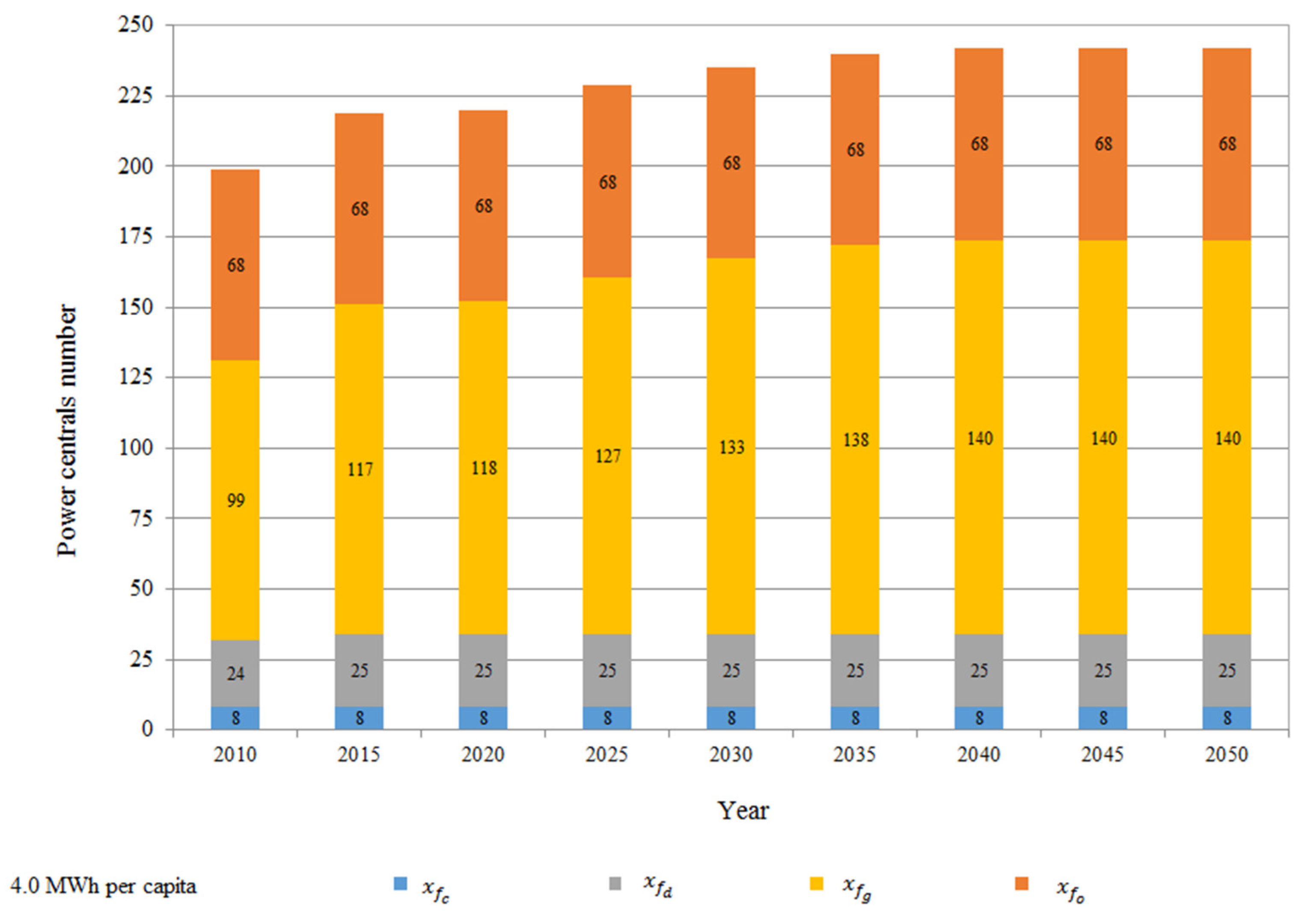
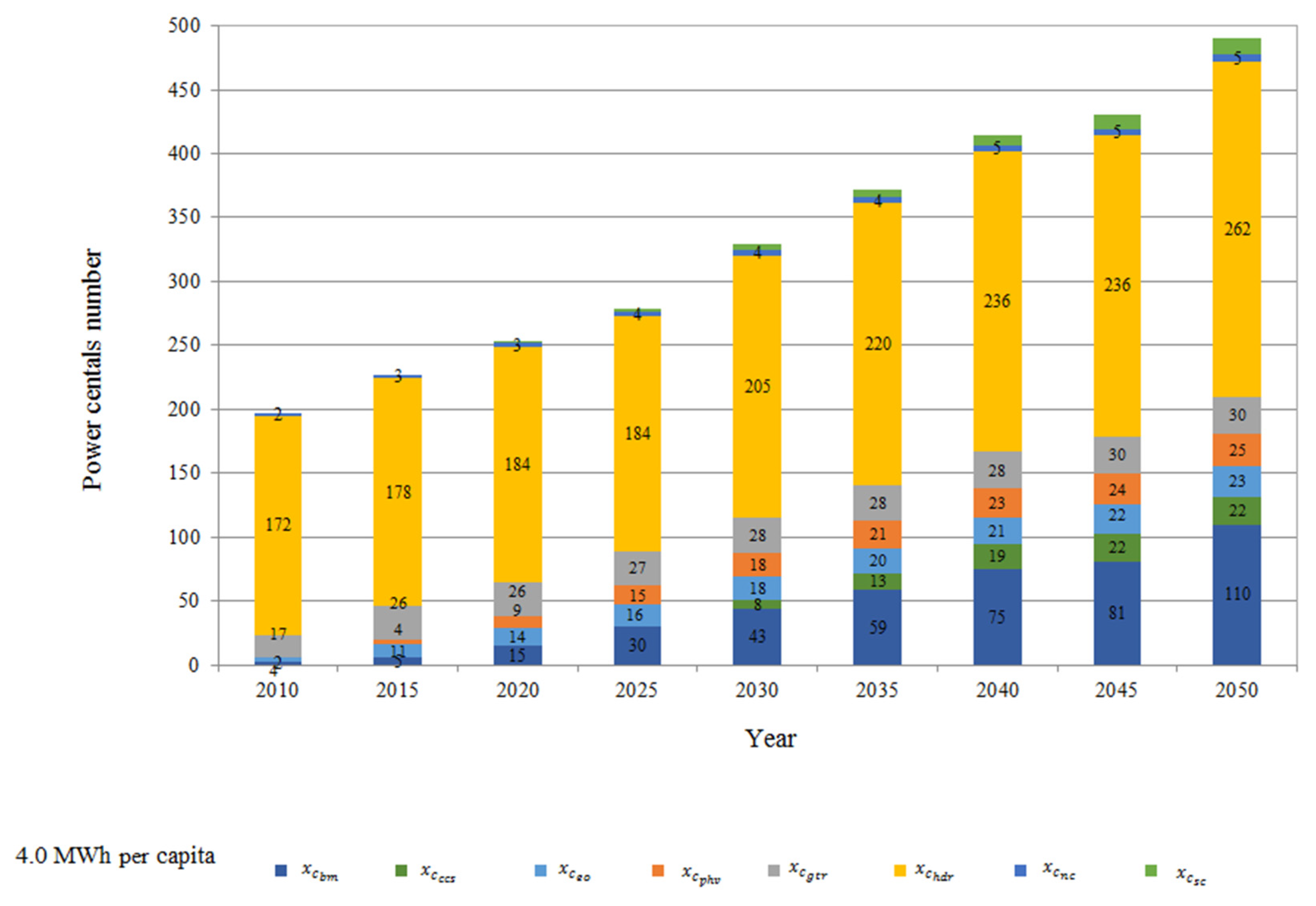


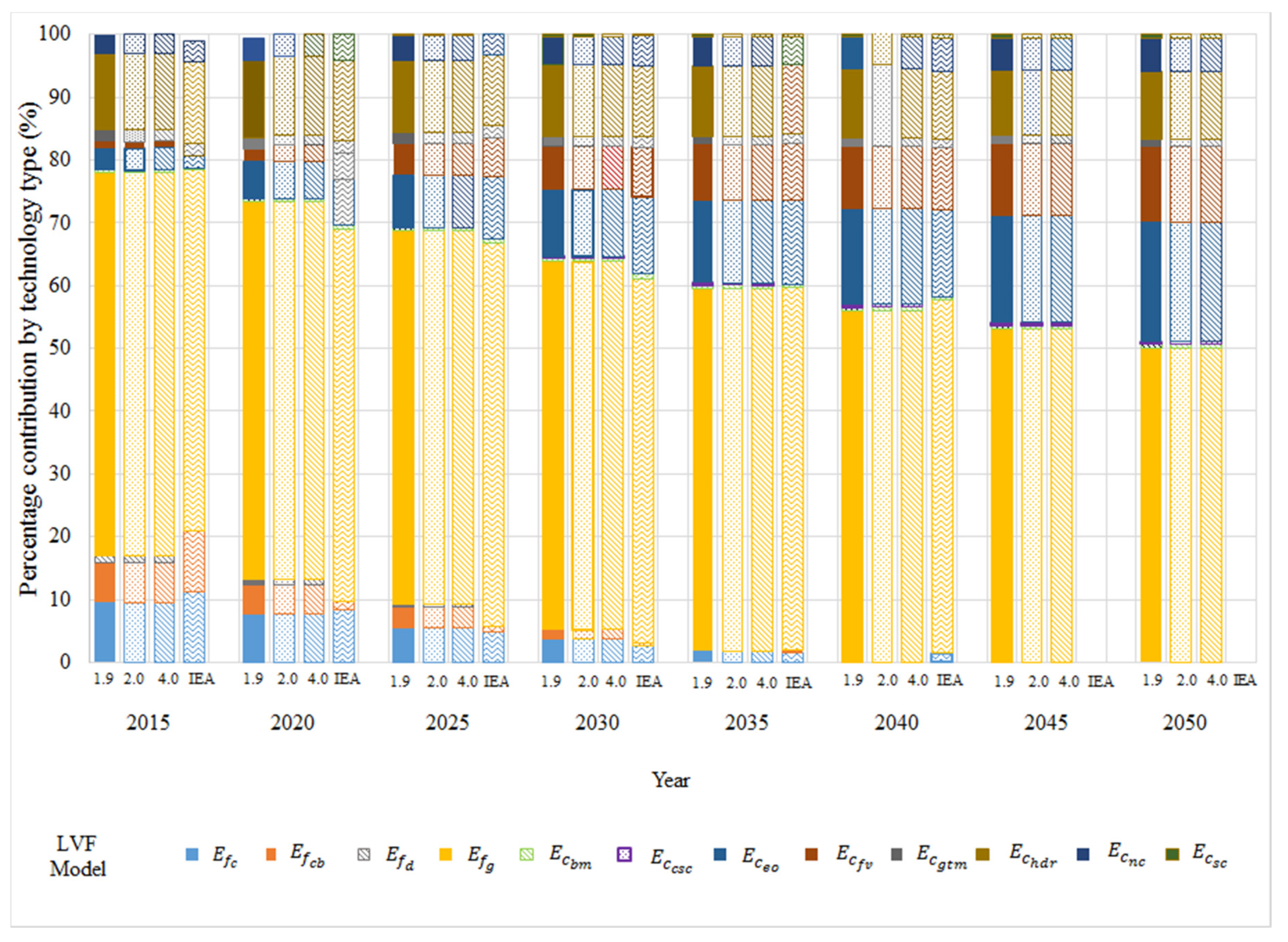
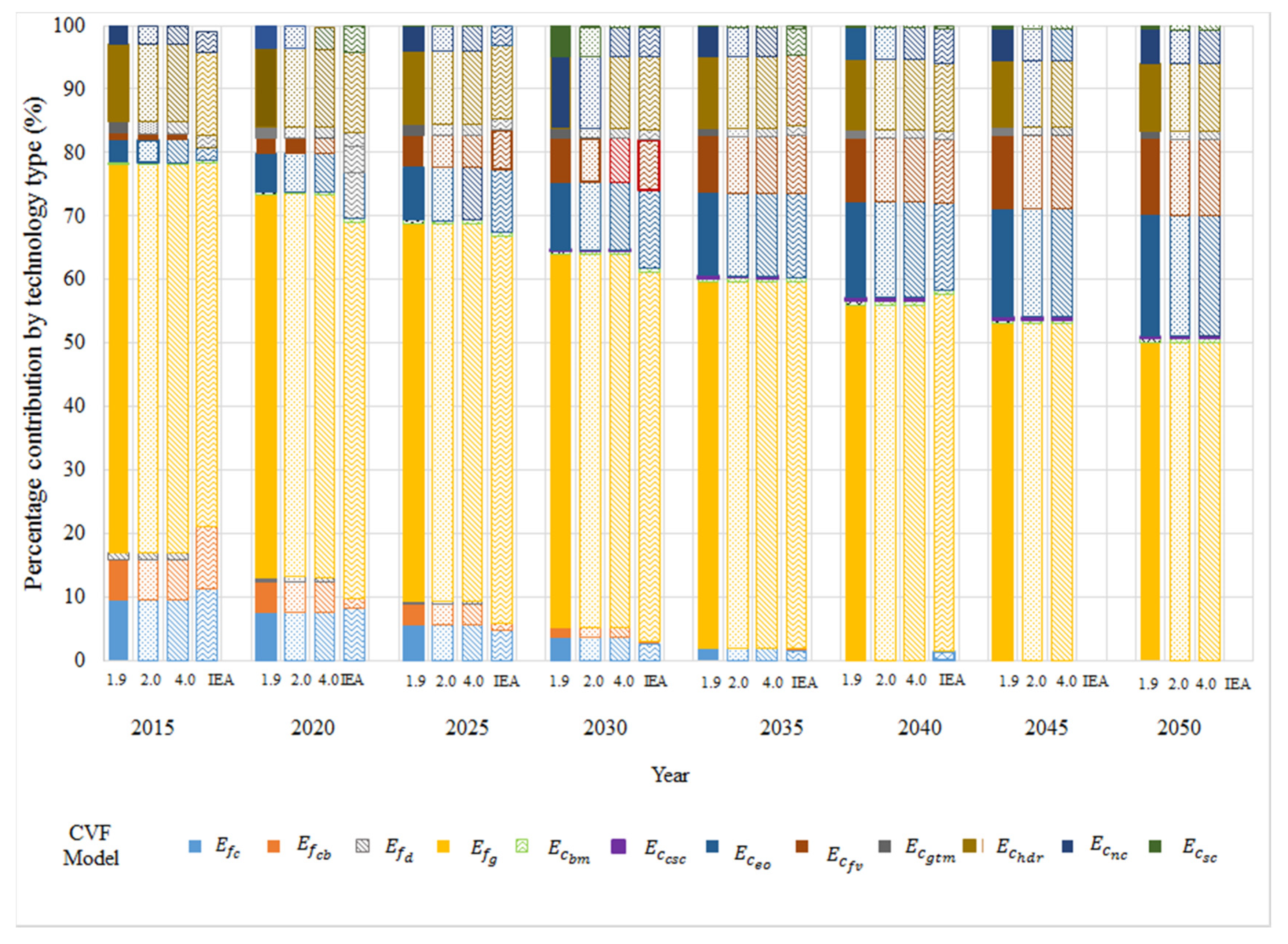
| Population Model | |||||||
|---|---|---|---|---|---|---|---|
| LVF | CVF | ||||||
| Electricity Demand [MWh per capita] | |||||||
| Year | 1.9 | 2.0 | 4.0 | 1.9 | 2.0 | 4.0 | |
| 2015 | LVF-1.9-2010 | LVF-2.0-2010 | LVF-4.0-2010 | CVF-1.9-2010 | LVF-2.0-2010 | LVF-4.0-2010 | |
| 2020 | LVF-1.9-2010 | LVF-2.0-2010 | LVF-4.0-2010 | CVF-1.9-2010 | LVF-2.0-2010 | LVF-4.0-2010 | |
| 2025 | LVF-1.9-2025 | LVF-2.0-2025 | LVF-4.0-2025 | CVF-1.9-2025 | LVF-2.0-2025 | LVF-4.0-2025 | |
| 2030 | LVF-1.9-2030 | LVF-2.0-2030 | LVF-4.0-2030 | CVF-1.9-2030 | LVF-2.0-2030 | LVF-4.0-2030 | |
| 2035 | LVF-1.9-2035 | LVF-2.0-2035 | LVF-4.0-2035 | CVF-1.9-2035 | LVF-2.0-2035 | LVF-4.0-2035 | |
| 2040 | LVF-1.9-2040 | LVF-2.0-2040 | LVF-4.0-2040 | CVF-1.9-2040 | LVF-2.0-2040 | LVF-4.0-2040 | |
| 2045 | LVF-1.9-2045 | LVF-2.0-2045 | LVF-4.0-2045 | CVF-1.9-2045 | LVF-2.0-2045 | LVF-4.0-2045 | |
| 2050 | LVF-1.9-2050 | LVF-2.0-2050 | LVF-4.0-2050 | CVF-1.9-2050 | LVF-2.0-2050 | LVF-4.0-2050 | |
| Electricity Generation Percentage by Energy Source, % | ||
|---|---|---|
| Year | Fossil, f | Clean, c |
| 2024 | 65 | 35 |
| 2035 | 60 | 40 |
| 2050 | 50 | 50 |
© 2019 by the authors. Licensee MDPI, Basel, Switzerland. This article is an open access article distributed under the terms and conditions of the Creative Commons Attribution (CC BY) license (http://creativecommons.org/licenses/by/4.0/).
Share and Cite
Hernández-Luna, G.; Romero, R.J.; Rodríguez-Martínez, A.; Ponce-Ortega, J.M.; Cerezo Román, J.; Toledo Vázquez, G.D. Energy Model for Long-Term Scenarios in Power Sector under Energy Transition Laws. Processes 2019, 7, 674. https://doi.org/10.3390/pr7100674
Hernández-Luna G, Romero RJ, Rodríguez-Martínez A, Ponce-Ortega JM, Cerezo Román J, Toledo Vázquez GD. Energy Model for Long-Term Scenarios in Power Sector under Energy Transition Laws. Processes. 2019; 7(10):674. https://doi.org/10.3390/pr7100674
Chicago/Turabian StyleHernández-Luna, Gabriela, Rosenberg J. Romero, Antonio Rodríguez-Martínez, José María Ponce-Ortega, Jesús Cerezo Román, and Guadalupe Diocelina Toledo Vázquez. 2019. "Energy Model for Long-Term Scenarios in Power Sector under Energy Transition Laws" Processes 7, no. 10: 674. https://doi.org/10.3390/pr7100674
APA StyleHernández-Luna, G., Romero, R. J., Rodríguez-Martínez, A., Ponce-Ortega, J. M., Cerezo Román, J., & Toledo Vázquez, G. D. (2019). Energy Model for Long-Term Scenarios in Power Sector under Energy Transition Laws. Processes, 7(10), 674. https://doi.org/10.3390/pr7100674









